This oldest part of Palermo is rich in history, churches, monuments and magnificent historic buildings. The Centro Storico is as much a reflection of the glorious past as of the dark one. But above all, Palermo's old town has an invaluable artistic and architectural heritage.
City map Palermo
The small streets of Palermo's old town are often confusing. So that no one gets lost, we have collected sights, useful and a few tips on a map. - For better visibility shown in purple.
Under the "tabs" above the map, the individual subject areas can be shown or hidden, split or displayed as a full screen.
Attention: This map is intended for private use only. We cannot guarantee the information contained in the map. This applies in particular to the accuracy, completeness and timeliness of the map. The use of the map is therefore at your own risk.
Quattro Canti
The intersection of two roads, Corso Vittorio Emanuele and Via Maqueda, forms Quattro Canti, or four corners. This square, framed by Baroque architecture, also divides Palermo's four historic districts:
Albergheria
Il Capo
La Kalsa – Tribunali
La Loggia – Castellammare
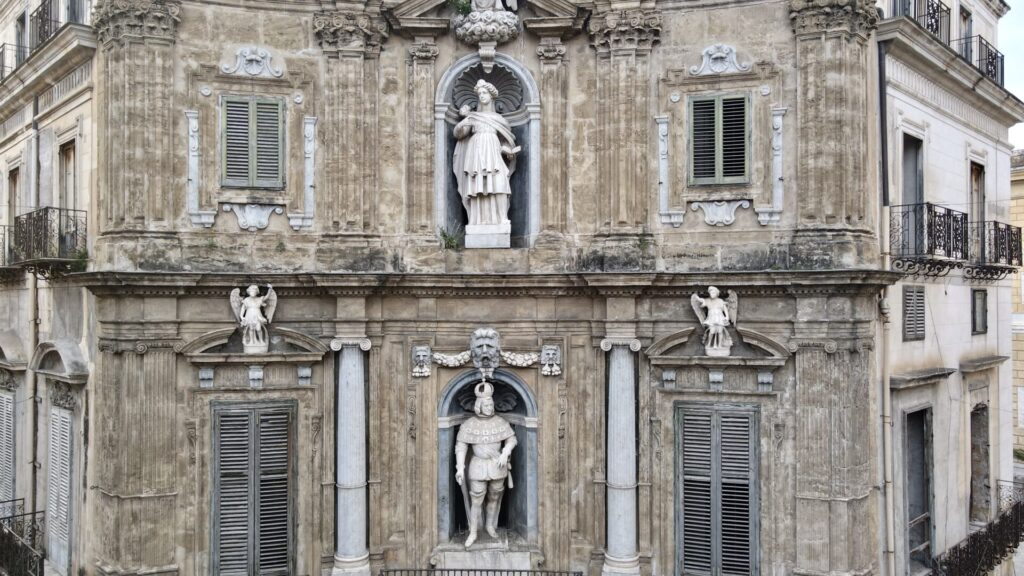
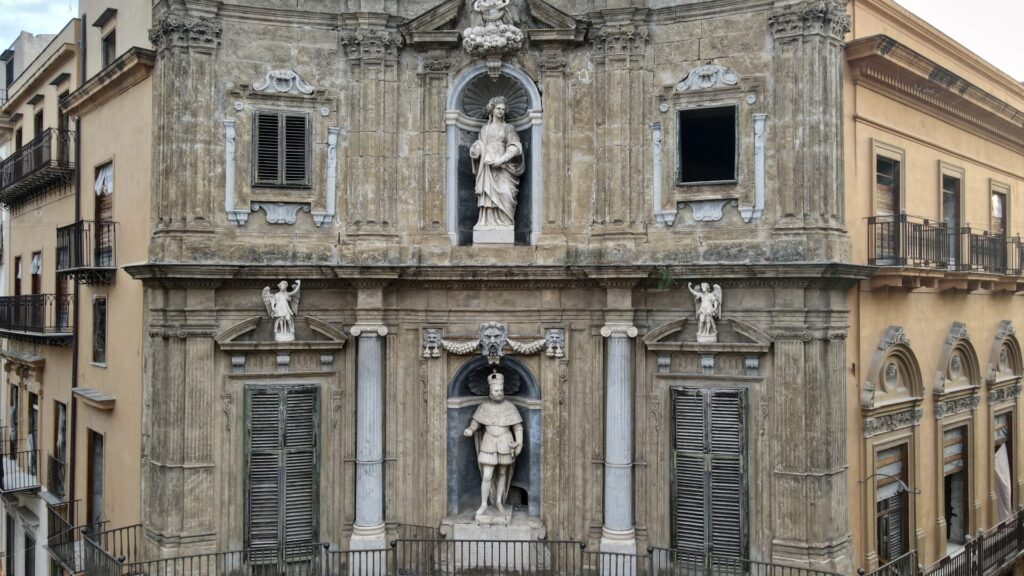
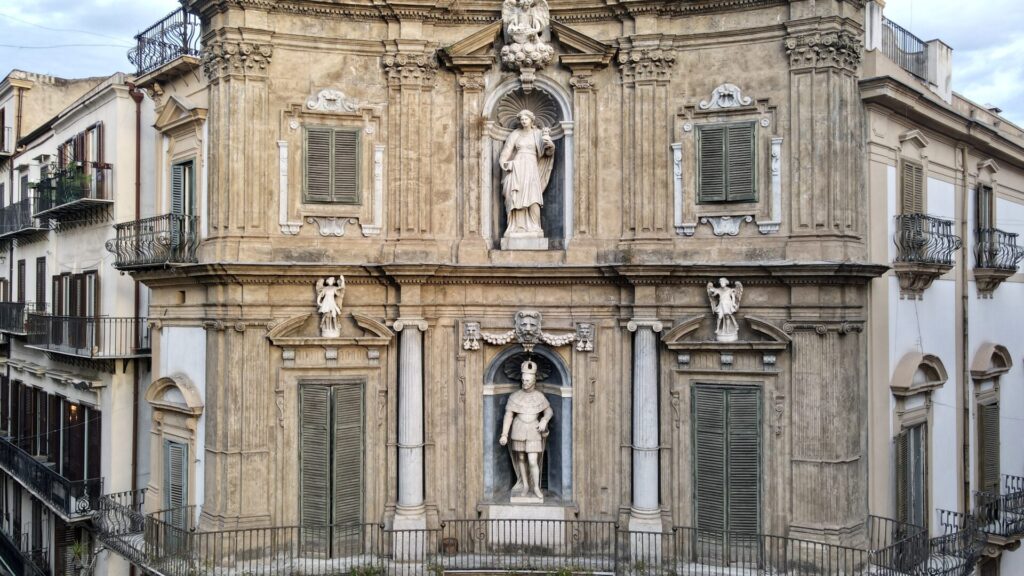
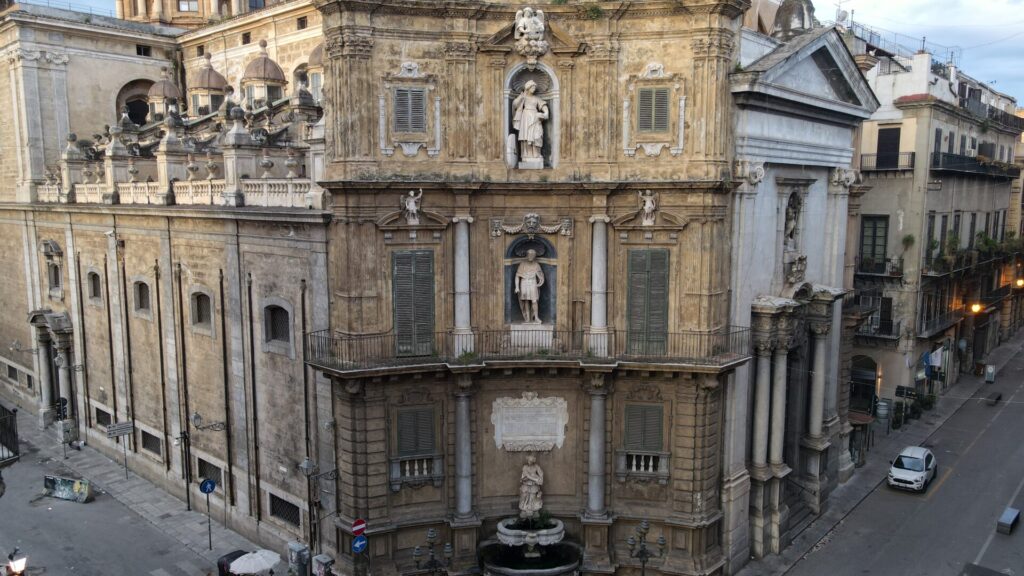
In the central area, in central niches, are the statues of the Spanish kings Charles V, Philip II, Philip III and Philip IV.
At the top are depicted the four patron saints of the old town quarters of Palermo.
The patron goddess Christina represents the old town district of Albergheria. Its location is south-southwest of the old town of Palermo. The young signora below represents the spring.
Patron goddess Ninfa, in turn, represents the old town district Capo in the west-northwest. The middle-aged signora for the summer.
Olivia represents La Loggia in the north-northeast. The more mature Signora below, in turn, represents autumn.
Followed by Agatha, which represents the Kalsa in the east-southeast. The very aged Signora, certainly a Nonna, symbolizes the winter.
Check out our post Palermo Street Art soon for some eerily beautiful references to Palermo's patron saints.
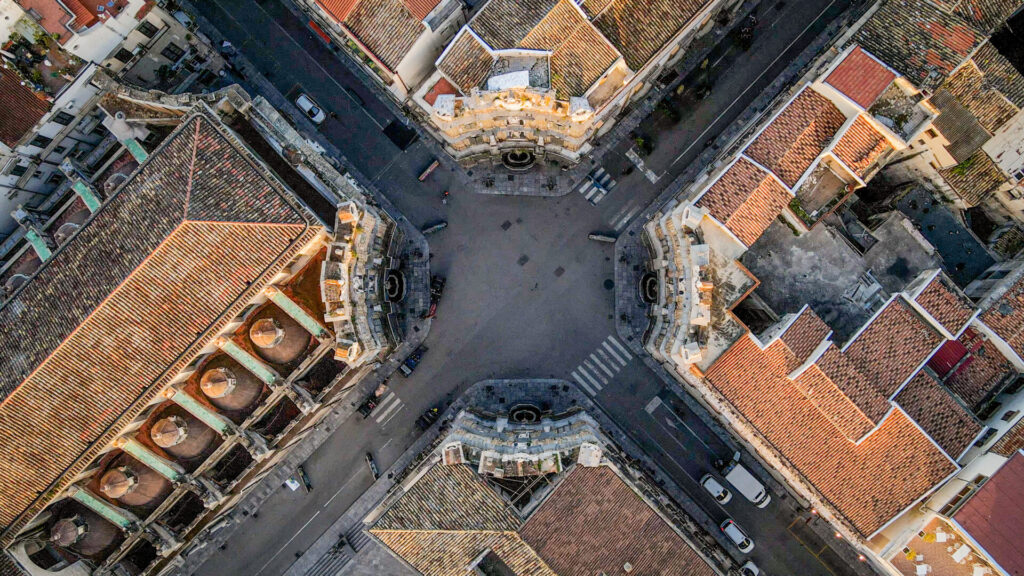
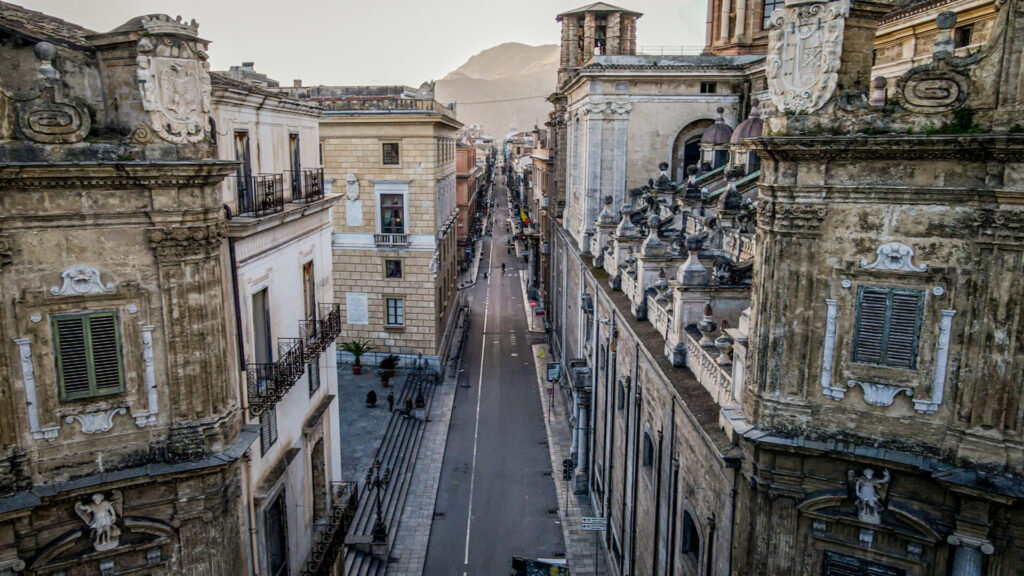
Old town quarter Albergheria
According to historians, the Albergheria is the oldest neighborhood of Palermo's old town. Here we can find evidence of the founders of the city. The Phoenicians landed here in the 8th century BC. The Greeks failed in their attempt to conquer. Romans, Byzantines, Arabs, Normans, French and Spaniards followed. Even today, the neighborhood stands for diversity.
This part of Palermo's old town is also known for its Norman architecture, the historic Mercato di Ballarò, and its street art.
You have a choice without agony: a link to Palermo Street Art you will soon find alternatively here or at the end of this post.
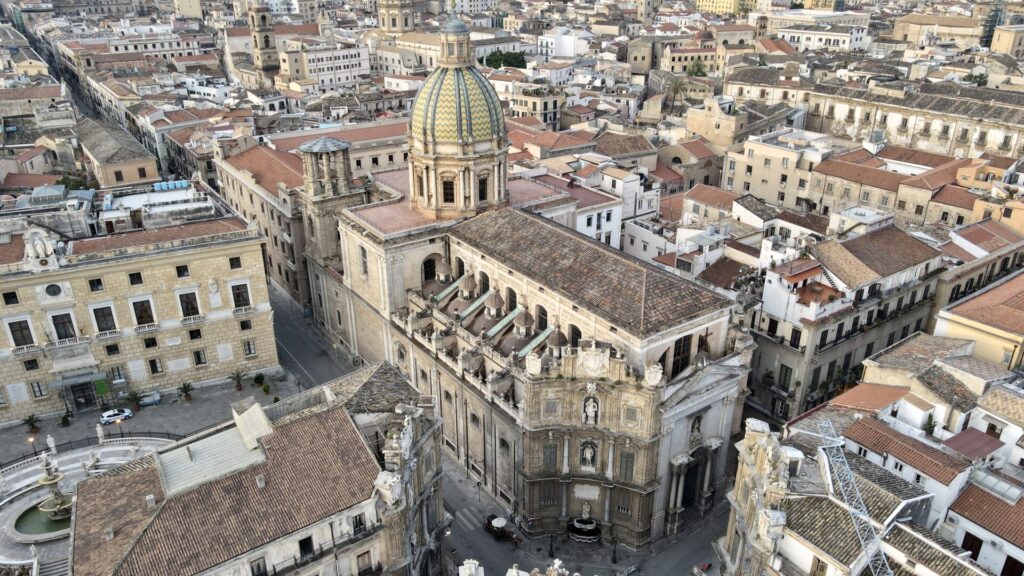
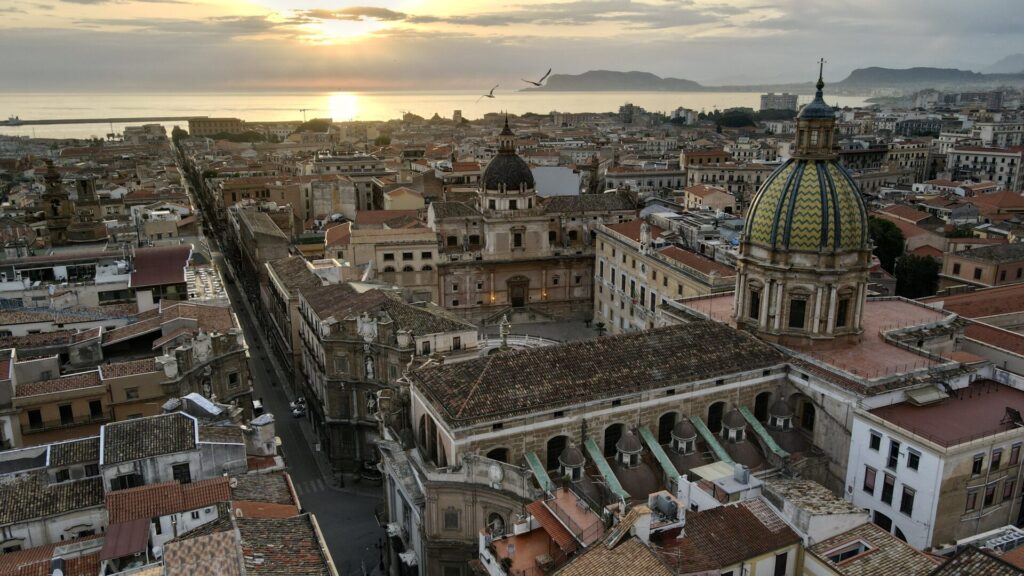
Chiesa di San Giuseppe dei Padri Teatini
The northeast corner of the old town neighborhood of Albergheria is simultaneously bounded by the southwest corner of the Quattro Canti. Have I confused enough?
From the perspective of the Quattro Canti, all four edges of the square resemble each other. But only at first glance. Because in the direction of Albergheria "hides" behind the facade the church of San Giuseppe dei Padri Teatini. - I hope you can see the baroque facade of the Quattro Canti as part of the church in the photo.
It is also worth taking a look at the rounded corner, which is also located to the right of the entrance portal. This is often referred to as the quintocanto, or fifth corner.
The buildings behind the other three Baroque facades of the Quattro Canti, on the other hand, are relatively plain. The church of San Giuseppe thus has a direct view of the square.
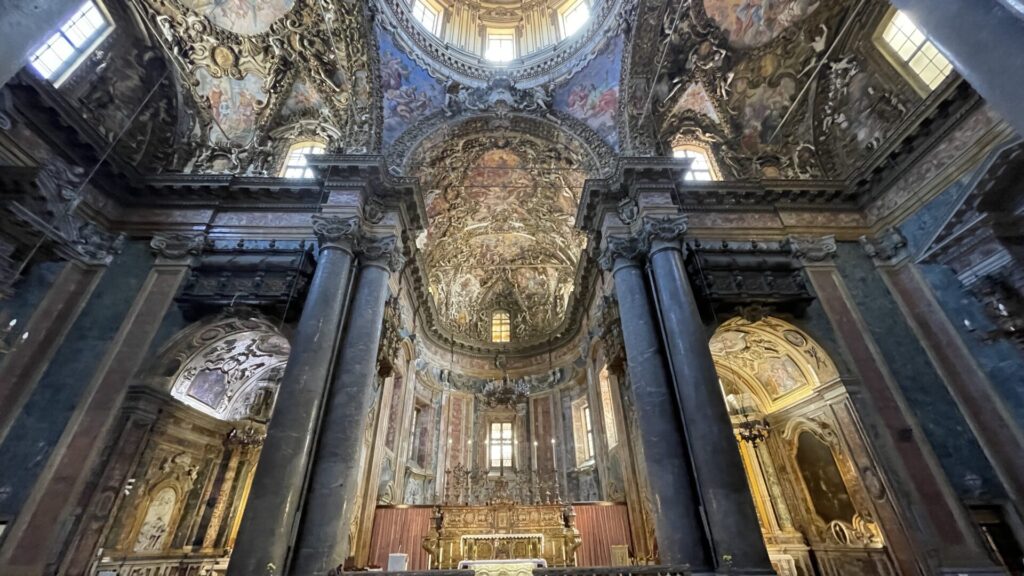
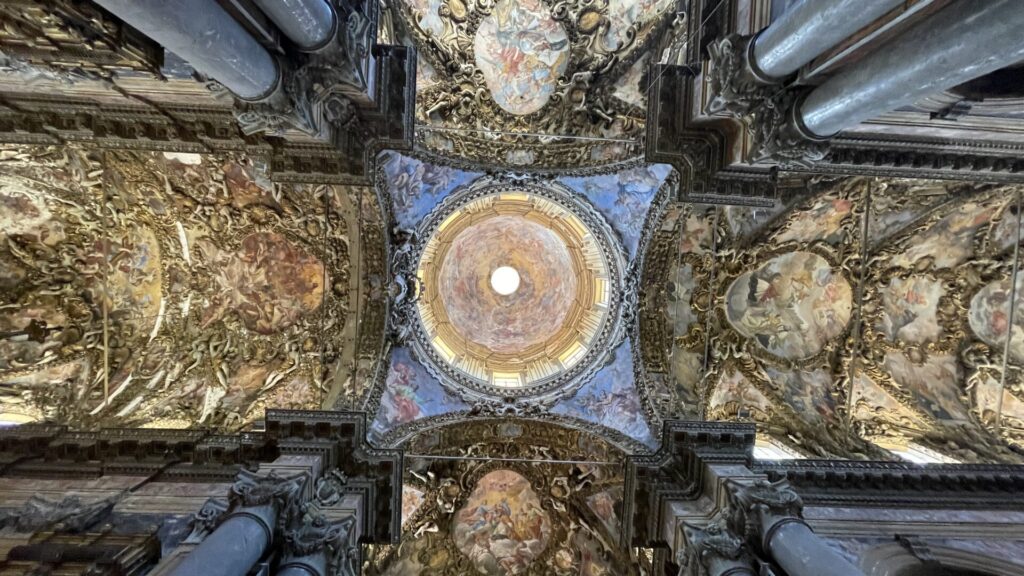
But it is their inner values, which particularly impressed us. Frescoes and works of art in abundance, can be admired here. What can not be admired, is the miracle what is hidden here. A mysterious bubbling spring, which is supposed to be in the crypt. That's how it is with miracles. They are always there, but they are not for everyone's eyes.
Next, let's move on to the tangible values of the old town district of Albergheria and the historic Mercato di Ballarò.
Ballaro
A market is a market, is a market... Yes, somehow it is. And yet this market is so very different. You can already tell that this market has done it to us.
And because the Ballarò is something very special, we will soon dedicate a separate blog post to it. Let us surprise you.


Chiesa del Carmine Maggiore
The tower of the Chiesa del Carmine Maggiore can be seen from all over Ballarò. Although the church dates from the 16th century, its origins date back to the 12th century. It stands out especially for its dome, richly decorated with tiles.

Torre di San Nicolo di Bari
From the nearby Torre di San Nicolò di Bari, a medieval tower, you can enjoy a perfect view over the roofs of Palermo's old town. The observation deck is open to visitors from Tuesdays to Sundays.
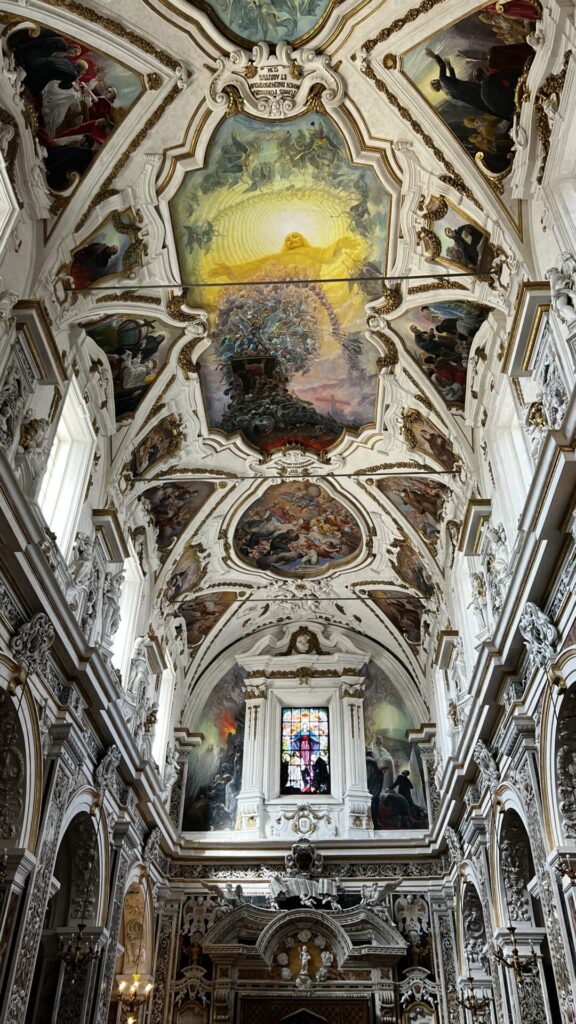
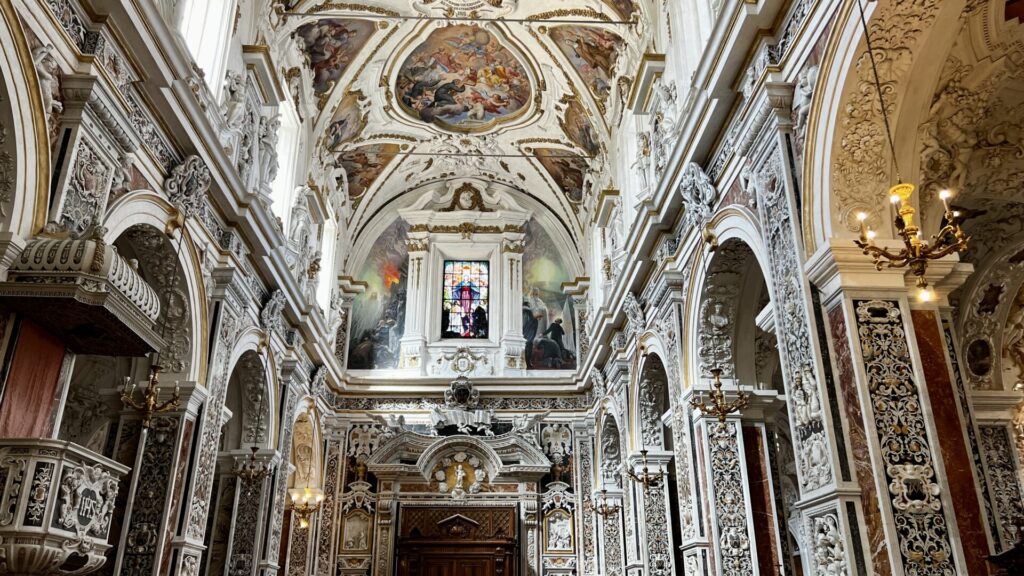
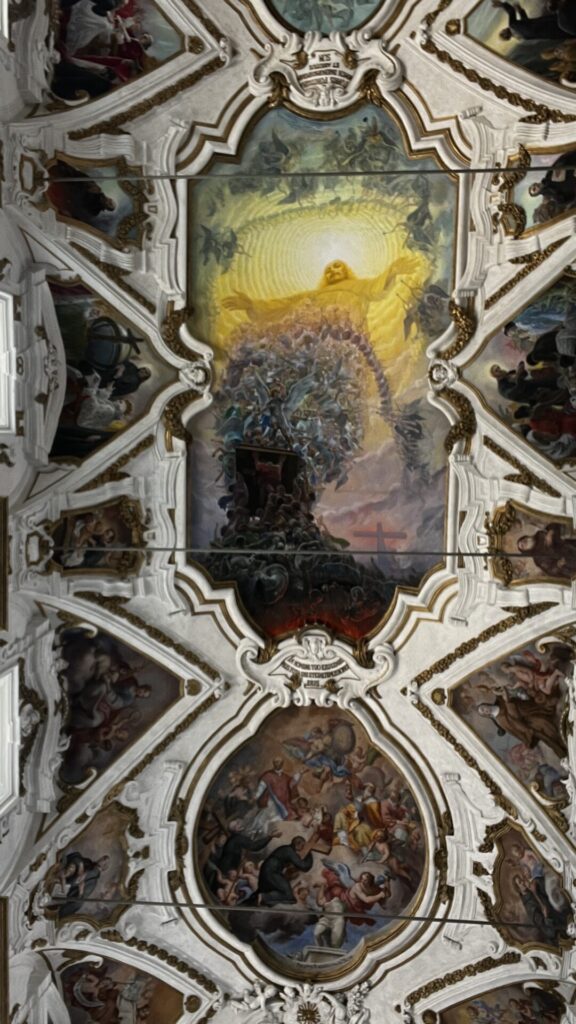
Chiesa del Gesu
Also in the Albergheria is the Chiesa del Gesù. This impressive baroque church with wonderful frescoes and numerous bas-reliefs from the 16th century is only 450 meters away from us.
At first glance, this church seems like many others in Palermo's old town. Most people simply pass by. But it is well worth entering. At first glance, one is almost overwhelmed by the vast amount of marble, inlays, statues and endless arabesques. Only with the second and third glance one is able to perceive the fusion of architecture, painting and plastic decoration.
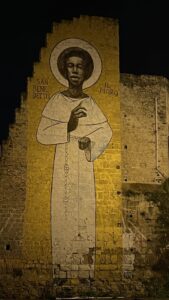
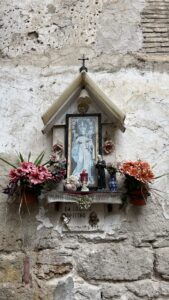
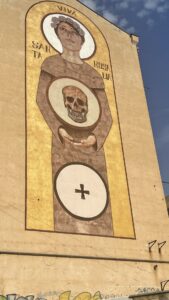
Chiesa di San Giovanni degli Eremiti
The Chiesa di San Giovanni degli Eremiti is 800 meters away. Thus, on foot about 10 minutes away. This is a medieval church with red domes, courtyard and Arab-Norman architecture.
Palazzo dei Normanni
The magnificent Palazzo dei Normanni is also called Norman Palace or Palazzo Reale ("Royal Palace"). It is not just any palace in Palermo's old town, but a symbol of culture, political power and above all wealth of the Norman kingdom. A must see in Palermo.
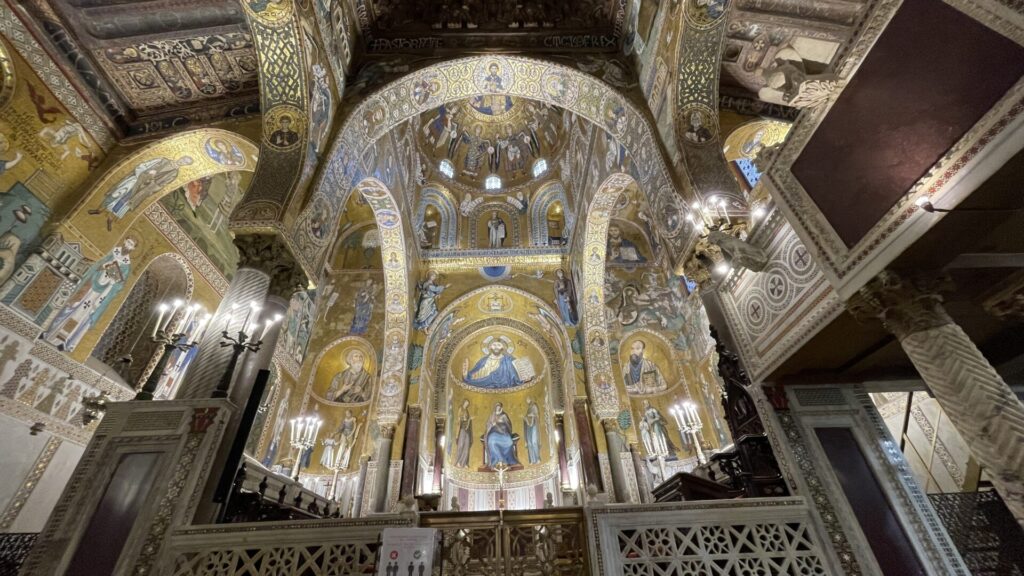
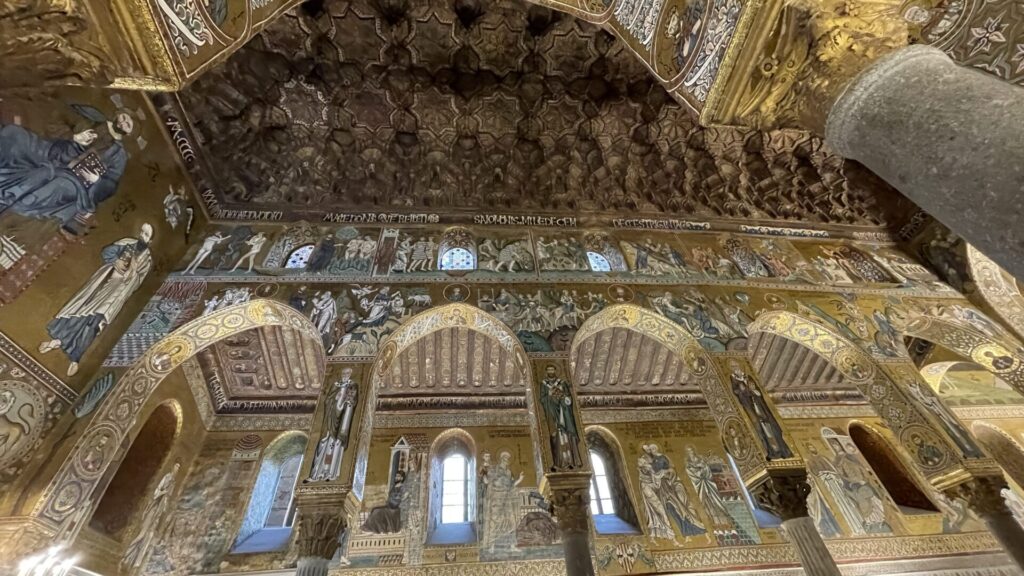
Cappella Palatina
This wealth is particularly evident in the magnificent Cappella Palatina, located in the Palazzo dei Normanni. With its ornate Byzantine mosaics and paintings, it is an absolute must-see in Palermo's old town. The palace and chapel are less than a kilometer and 15 minutes away on foot.
Tip: Strict security measures apply in the Norman Palace, including the Cappella Palatina. Bags are scanned just like at the airport. Therefore, you should pay attention in advance to what you carry with you. Pocket knives for snacks are not conducive here. I speak from experience. In case of emergency, pocket knives or similar can be left at the ticket counter.
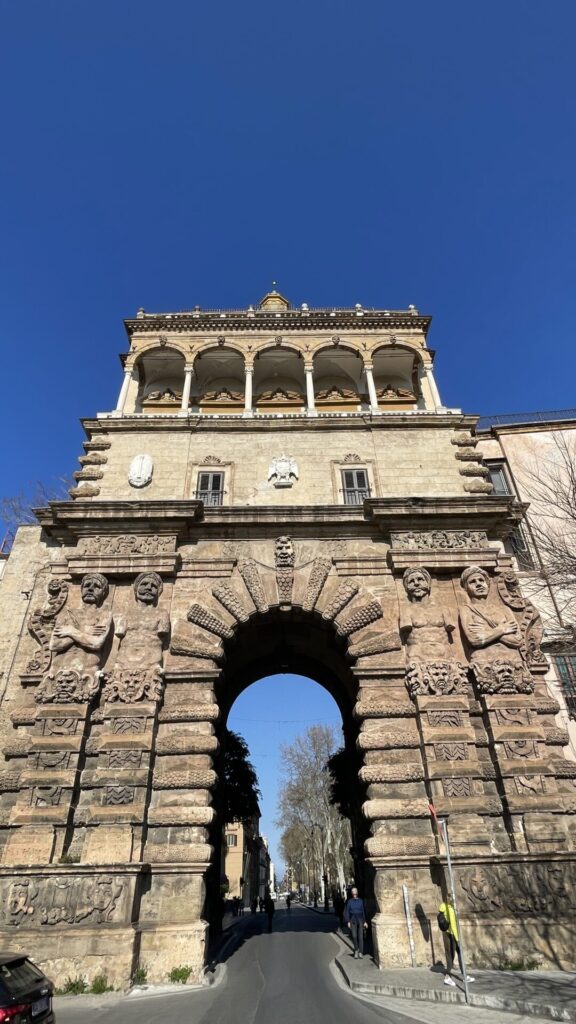
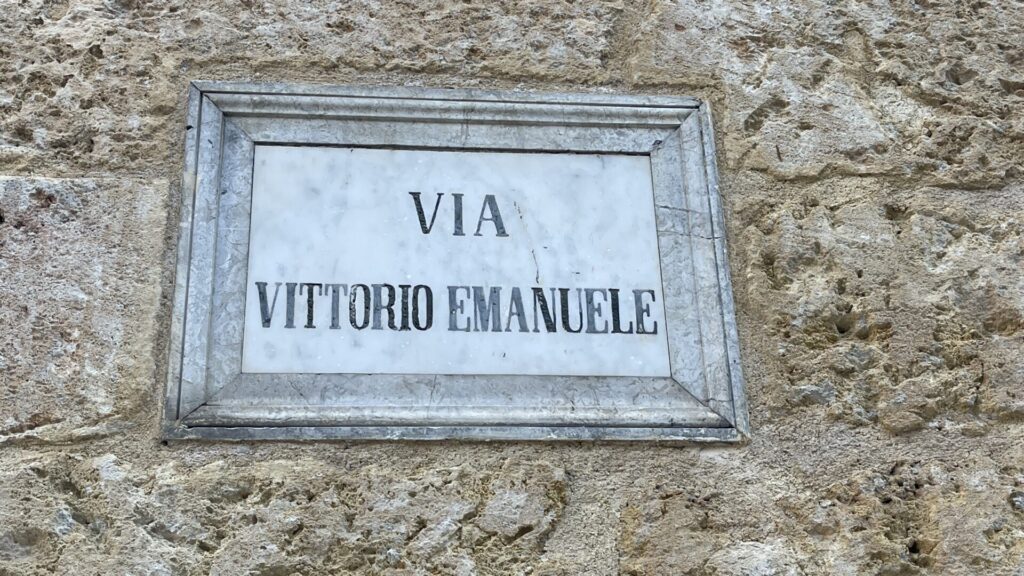
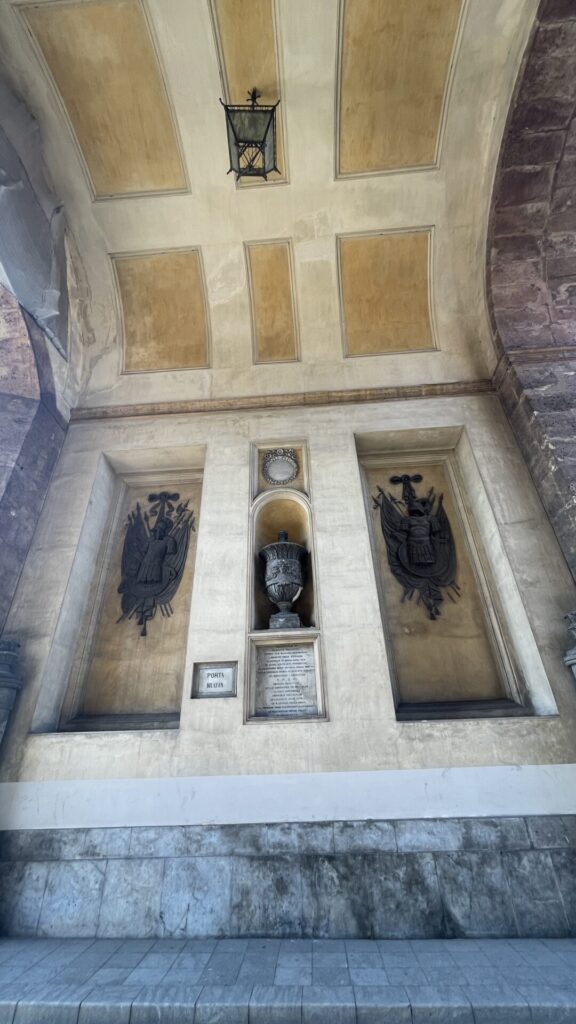
Porta Nuova
Right next to the Palazzo dei Normanni is the Porta Nuova and thus the boundary of the old town. This striking 43-meter-high structure, dating from 1570, is both a gateway and a triumphal arch.
So, the so-called new gate is already old and was built in place of an already existing city gate.
It commemorates the victory of Charles V in Tunisia in 1535. This victory is represented by four Moors carved into the façade on the outside.
The Porta Nuova was for centuries the most important city gate of Palermo. From here, Corso Vittorio Emanuele leads across the Quattro Canti, to Porta Felice and thus to the sea.
At Quattro Canti, Corso Vittorio Emanuele crosses Via Maqueda.
Enough sightseeing for today? Then we recommend relaxing under magnificent palm trees directly opposite the entrance to the Norman Palace, in Villa Bonano Park.
Still not enough? Then let's go to the Capo Quarter.
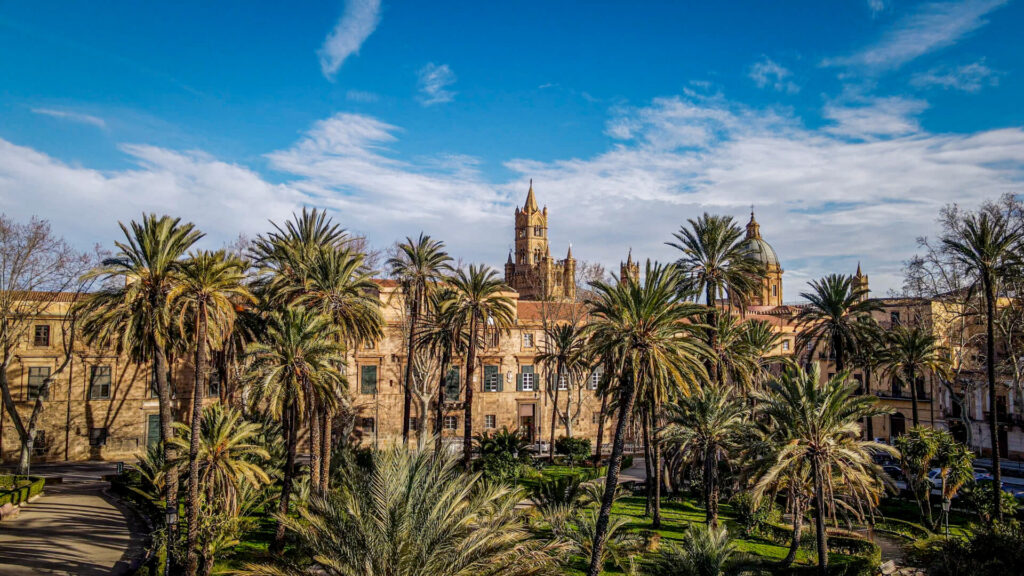
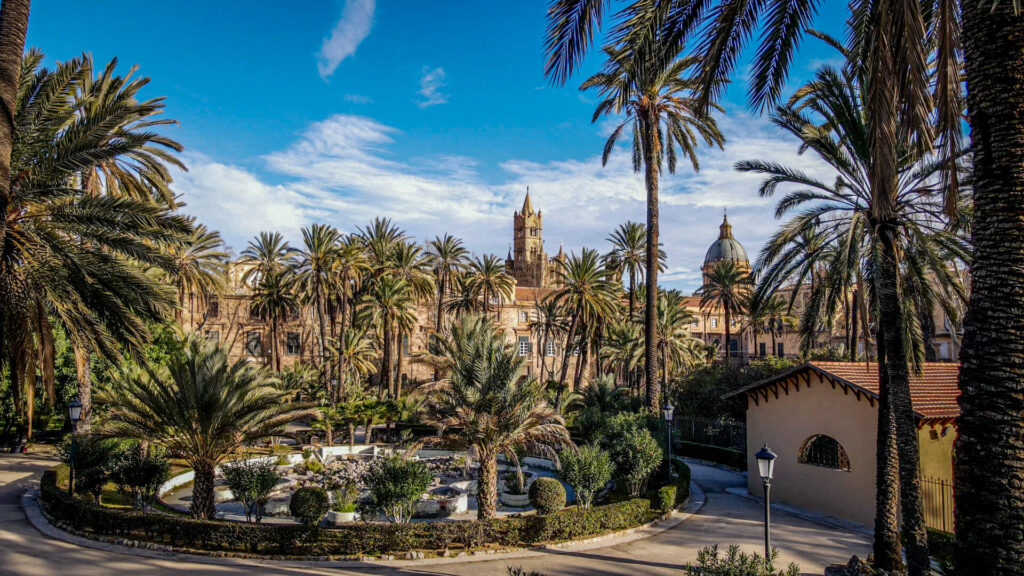
Old town quarter Il Capo
Too often, Palermo's Capo neighborhood is limited to the historic market of the same name.
Therefore, we recommend approaching the neighborhood differently.
Cattedrale di Palermo
If you follow Corso Vittorio Emanuele from Porta Nuova towards the sea, after about 450 meters you will reach the square, in front of the Cattedrale di Palermo.
Before you enter the church, don't forget to take a look at the Statua di Santa Rosalia. She is the patron saint of Palermo.

Tip: Visitors are admitted at the same time. Those who are good on foot should go ahead on the ascent and let them go ahead on the descent. Thus, not only those who are less brisk have leisure, but you get to thank on top the most beautiful photos.
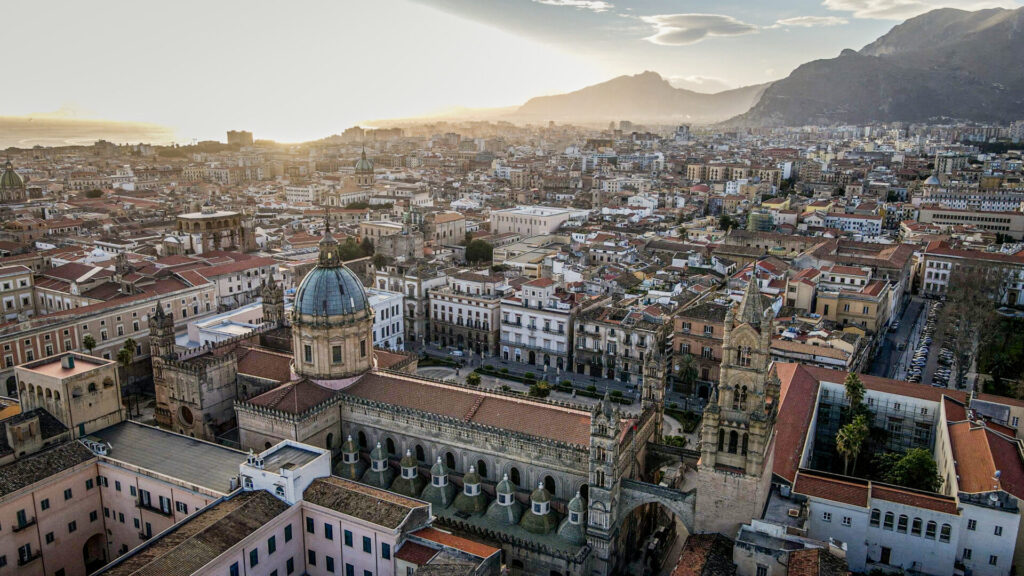
If you keep to the right as you leave the cathedral, you will reach Via Matteo Bonello. Here is also the Museo Diocesano di Palermo, Diocesan Museum of Palermo.
Tip: It's worth taking at least a few steps into the courtyard. If you turn around in the direction of the cathedral, the archway provides a perfect frame for a photo of the cathedral. At least, if there isn't a construction container blocking the view.
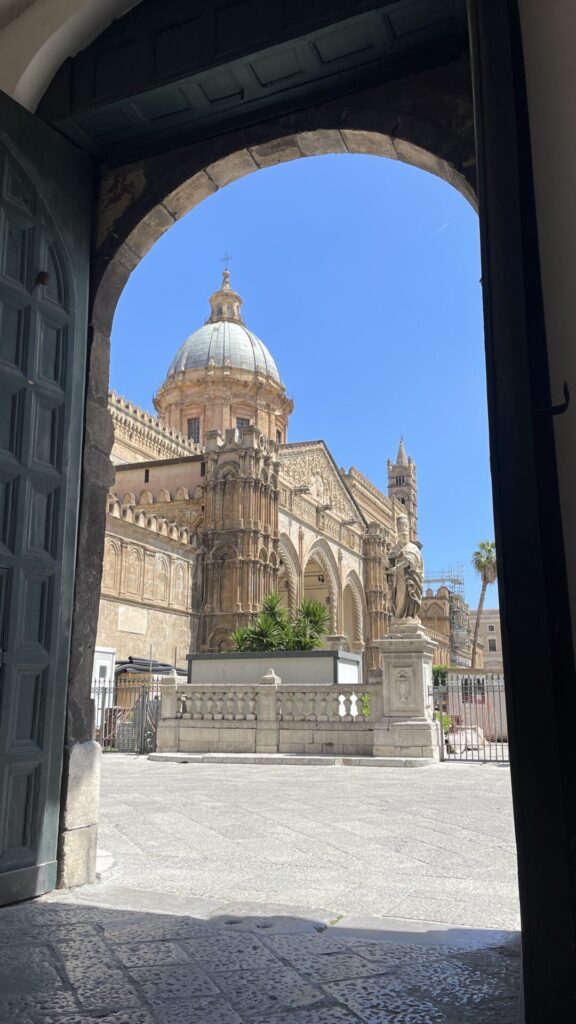
Mercato delle Pulci
If the Museo Diocesano is too heavy for you, just follow the road along the cathedral, keeping to the left. After 270 meters you can climb a few steps on the left. Here begins Piazza Domenico Peranni and thus the Mercato delle Pulci.
This is the antique market of the city. Literally translated, it is also just called the market of fleas. Exciting are the antiques, the trees, which grow right through the roofs of the stores.


Mercato di Capo
From here it is only a few meters to Via Mura di Porta Carini and the Mercato di Capo. Along with the Ballarò, the Capo is not only a classic weekly market, but also a meeting place for street food fans. The end of the market and the old town is Porta Carini. So quickly turn around again to possibly take a photo.
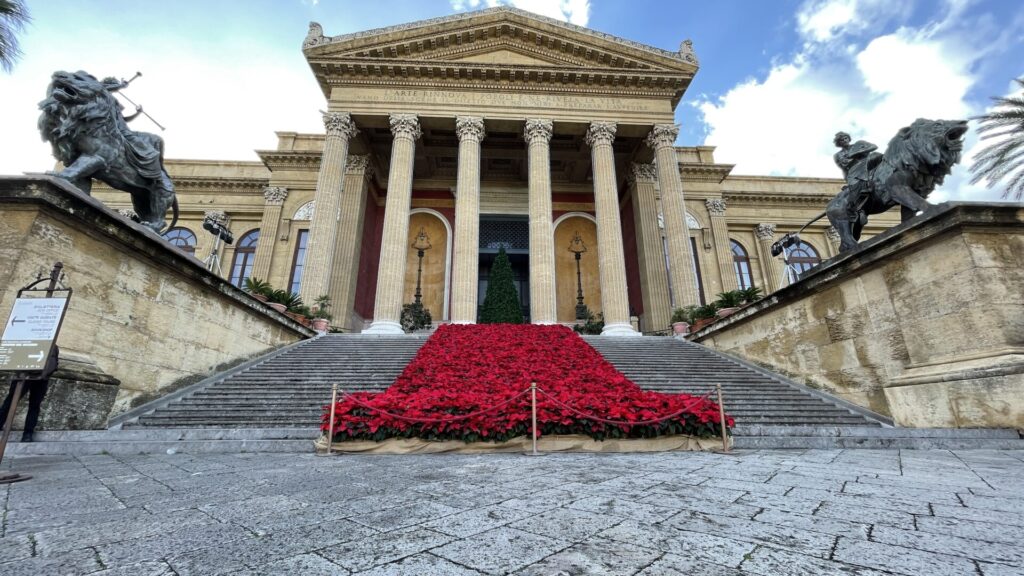
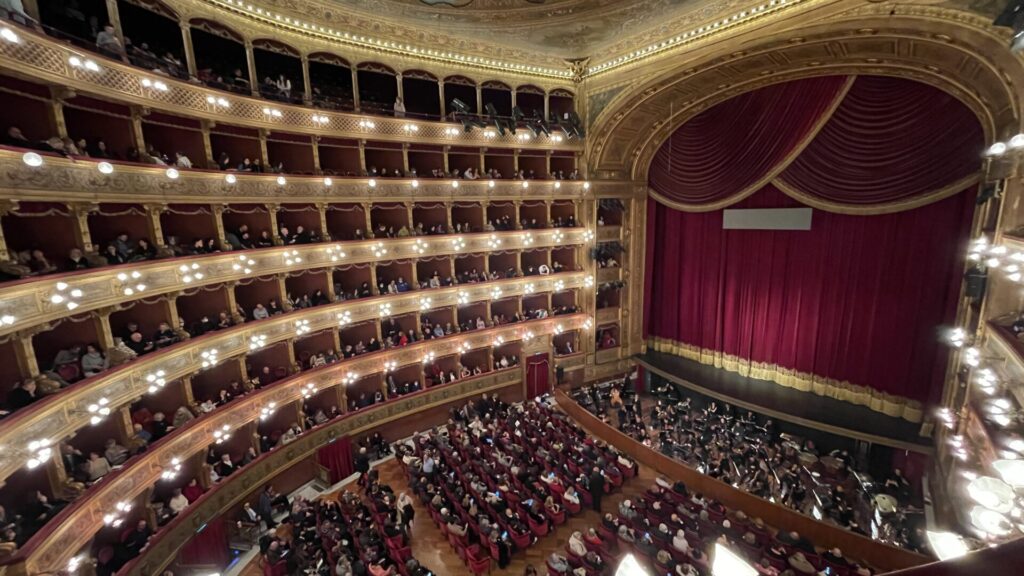
Teatro Massimo
If you follow Via Volturno on the left from Porta Carini, you will reach Teatro Massimo after 300 meters and you will come back to Via Maqueda. Despite its name, the Teatro Massimo is known primarily as an opera house. The large dome gives an idea that it is the third largest opera house in Europe.
Fans of the film trilogy "The Godfather" will certainly recognize the Teatro Massimo. Because this is where the final scene was shot. Unfortunately, the history of this house is closely interwoven with the Mafia, and not only in the film. Due to structural deficiencies, there was a "provisional closure" of the opera house in 1974.
However, the contractors commissioned were closely linked to the mafia. The "redevelopment" dragged on for more than 20 years. In return, the Mafia allegedly met here to play cards. The fact that the theater was reopened in 1997 for its 100th anniversary is mainly thanks to the former mayor Leoluca Orlando. Today, the Massimo is considered a symbol of Palermo's fight against the Mafia and, of course, a cult place of the opera.
And from our own experience we can say that a visit to the opera is well worthwhile. Torgit and I were last able to see and hear "La Traviata" here. - We felt a little reminded of the corresponding scene in the movie Pretty Woman.
But I had something completely different in mind in between. And that's why I had to keep looking up. Because that's where the so-called gossip boys used to sit. Their job was to initiate the applause.
One of those clapping boys was my uncle Mario, who was born in Palermo. It was a funny-beautiful feeling to sit there and listen to the applause. I wonder what my late uncle would think if he had seen me sitting there?
Back to the street. - From the Teatro Massimo you can return via Maqueda in the direction of Quattro Canti.
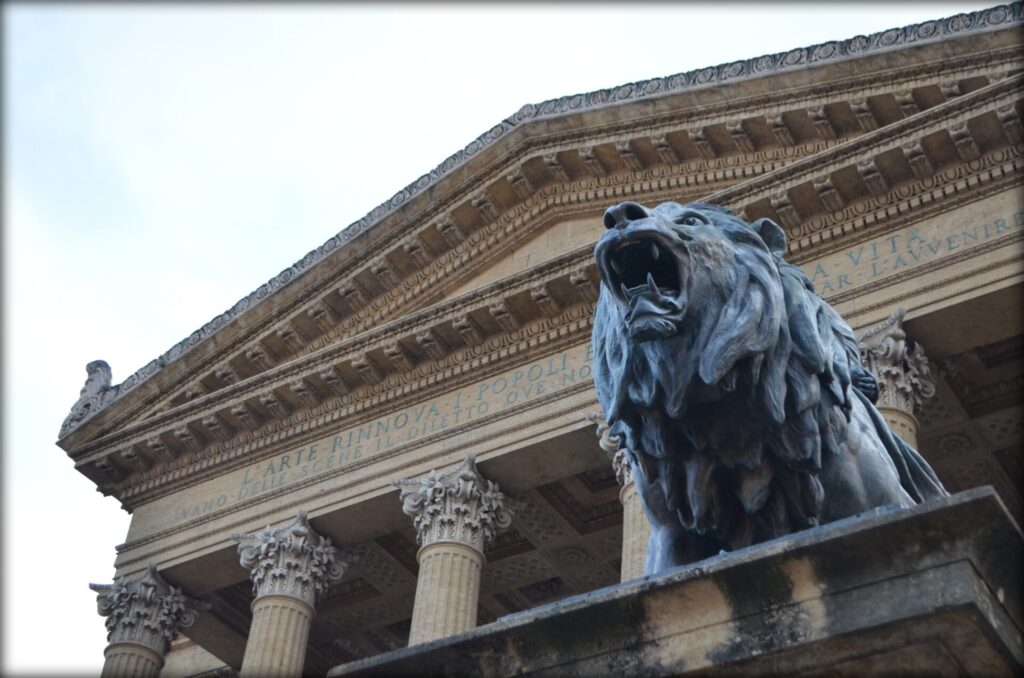
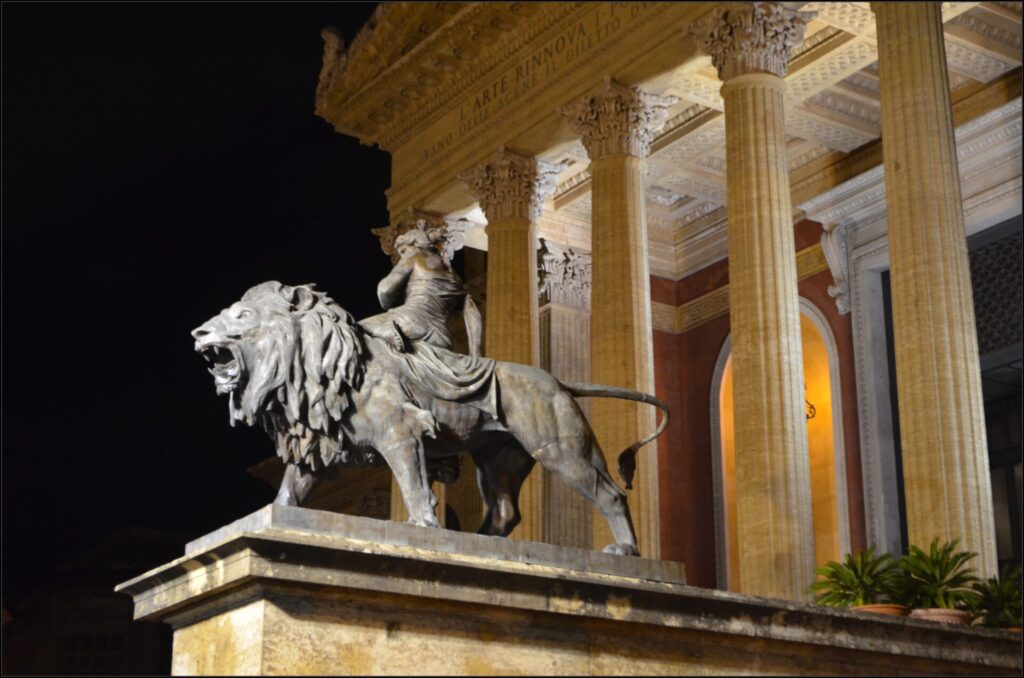
Old Town Quarter La Kalsa | Tribunali
On the other, the western side of Via Maqueda, begins the Kalsa, which extends to the sea.
Directly on Via Maqueda, coming from Ballaro, on the right, after about 700 meters, is Piazza Bellini.
Here stands the
Chiesa di San Cataldo
Our ideas of a Norman church were previously shaped by the Cathedral of Bayeux, the nave of the Abbey of Mont Saint-Michel, or the Church of Saint Nicolas of Caen. At least until we came to Cefalù and Palermo.
Because what we thought were obviously Arabic here are mostly Norman churches. So is this, our favorite church in Palermo, the Chiesa di San Cataldo.
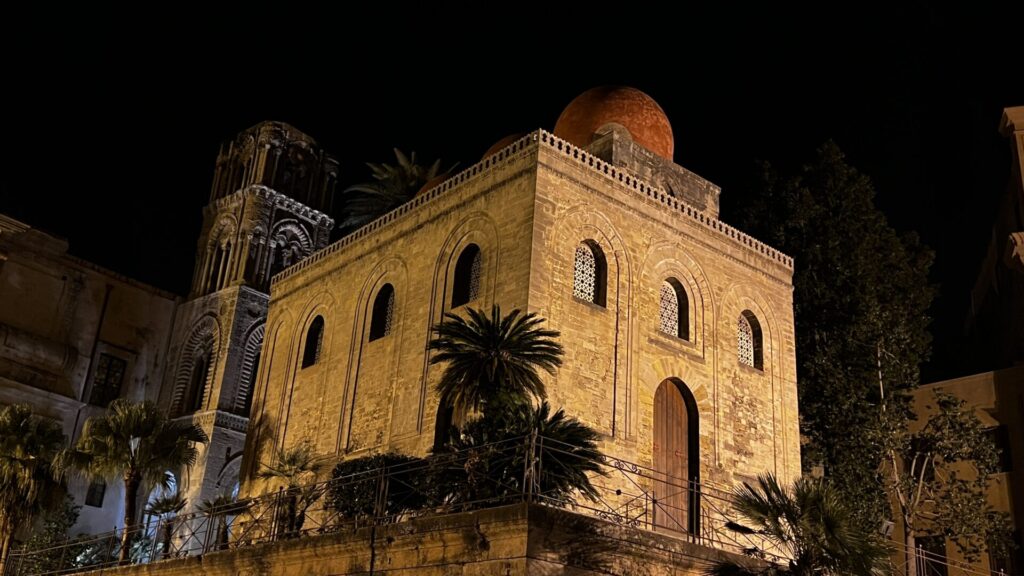
Thus was born an architectural masterpiece. Norman and Arab at the same time. New German multicultural. The Chiesa di San Cataldo impresses above all with its clear walls. Three domes cover the central nave.
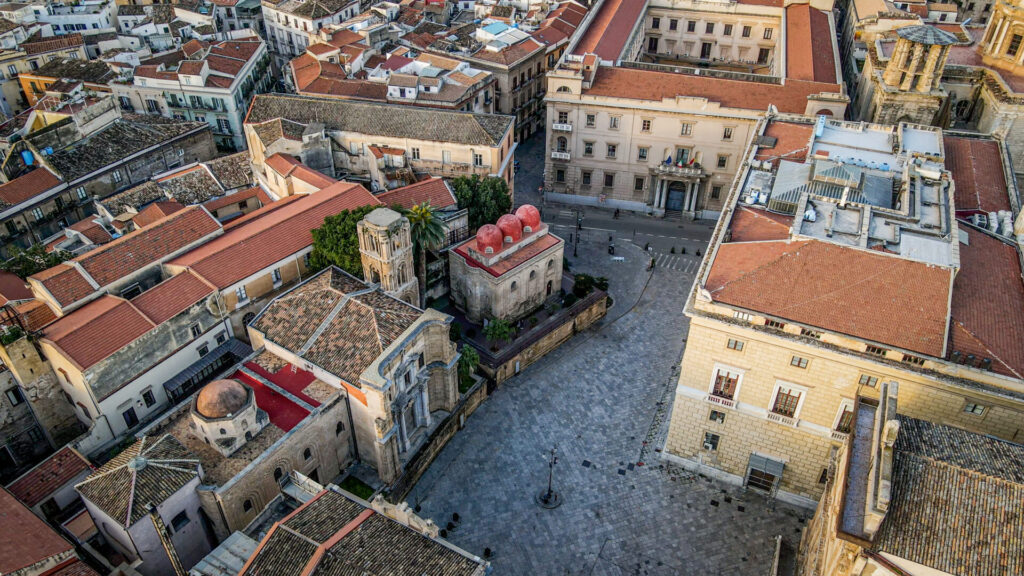
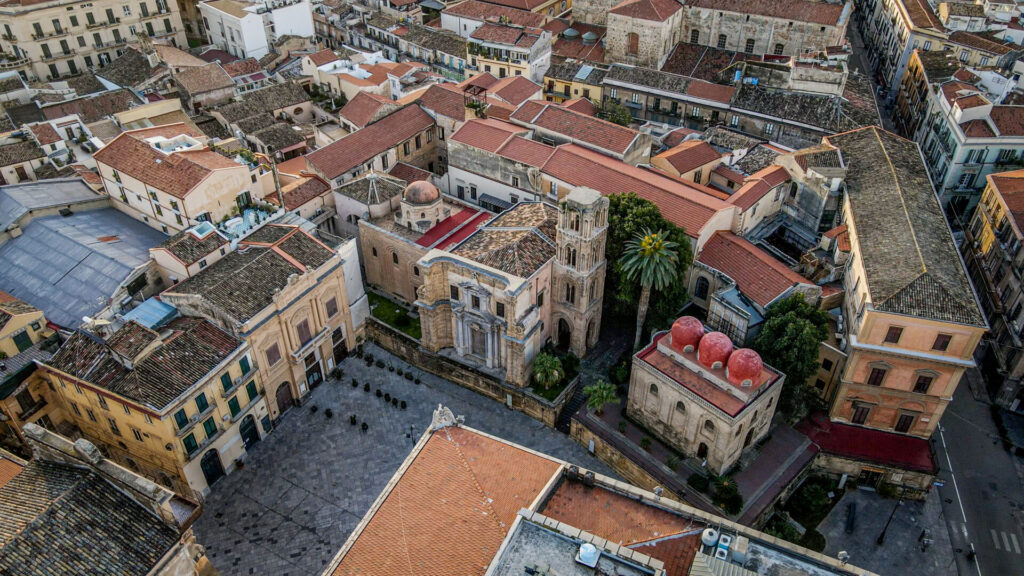
Santa Maria dell'Ammiraglio
Right next door is the so-called Admiral's Church. Also a Norman domed church. However, here with ornate Baroque elements, known for its imposing Byzantine mosaics. The absolute opposite of the simplicity next door. You should bring some time to take in all the images.
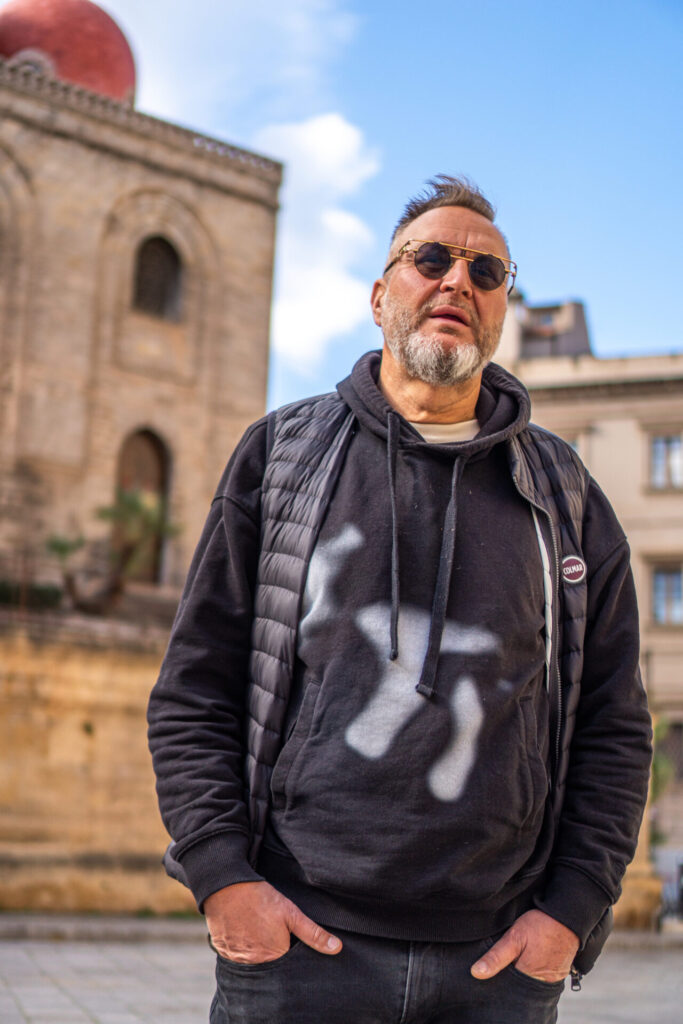
Chiesa e Monastero di Santa Caterina d'Alessandria
Diagonally opposite the Admiral's Church, is the Chiesa e Monastero di Santa Caterina d'Alessandria. This church belongs to a former Dominican monastery and consists of church, monastery, terraces and the former monastery bakery.
This church can also best be described as magnificent. As is the case for many churches, admission is charged for this one as well. Those who are not deterred by this should choose the combination with access to the terraces. Because the view of the city is worth it in any case.
After all these impressions, our senses certainly deserve a little break. How about something sweet?
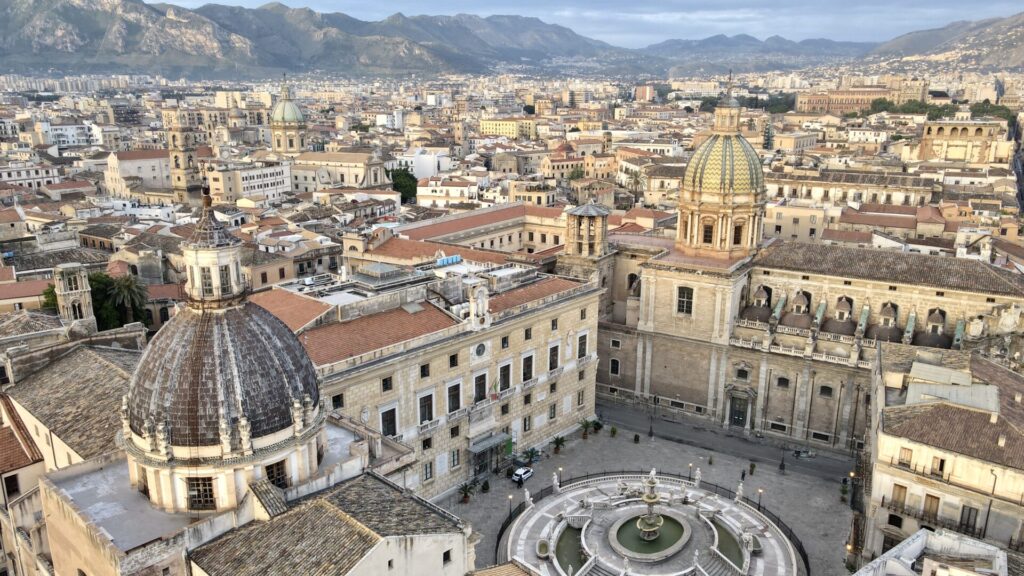
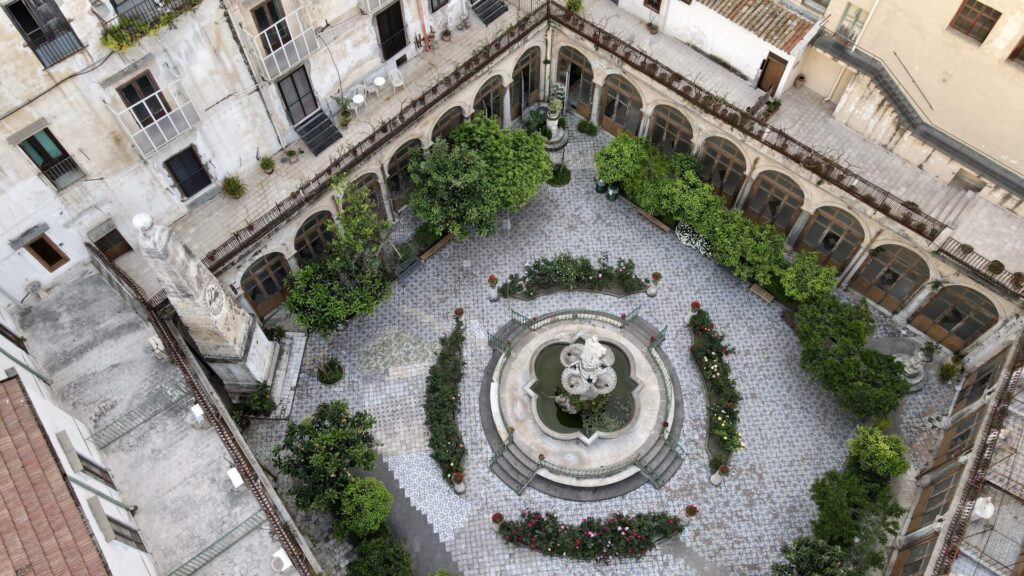
La Dolceria di Santa Caterina
The entrance to the Dolceria di Santa Caterina, is right next door. The visit to this supposedly best cake bakery of Palermo is worthwhile for several reasons. In the "spezieria" or "pastry shop" of the convent of Santa Caterina, ricotta cakes, filled pasticciotti, pancakes, almond cookies, and much more are produced according to ancient recipes of the convent. For a long time, the sale of sweets ensured the survival of the monastery. Today it tastes simply divine.
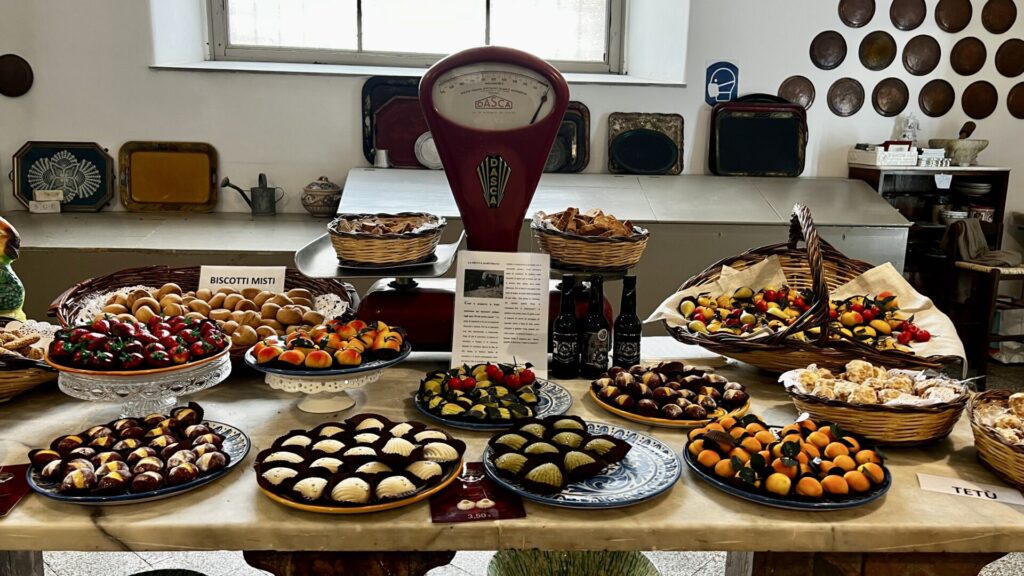
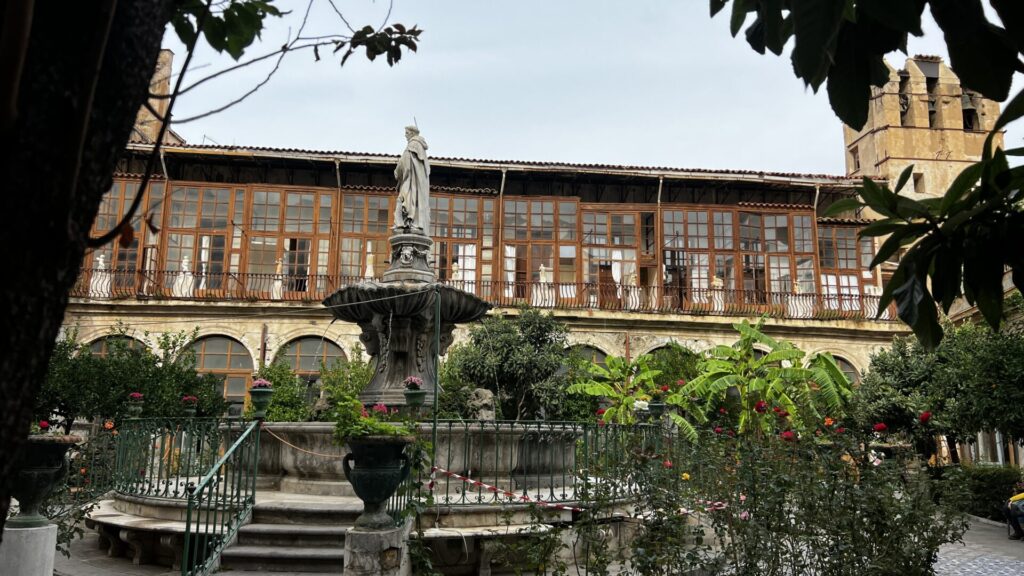
Still missing a good espresso to sweeten it up? Then let's go next door. Because here you will find the...
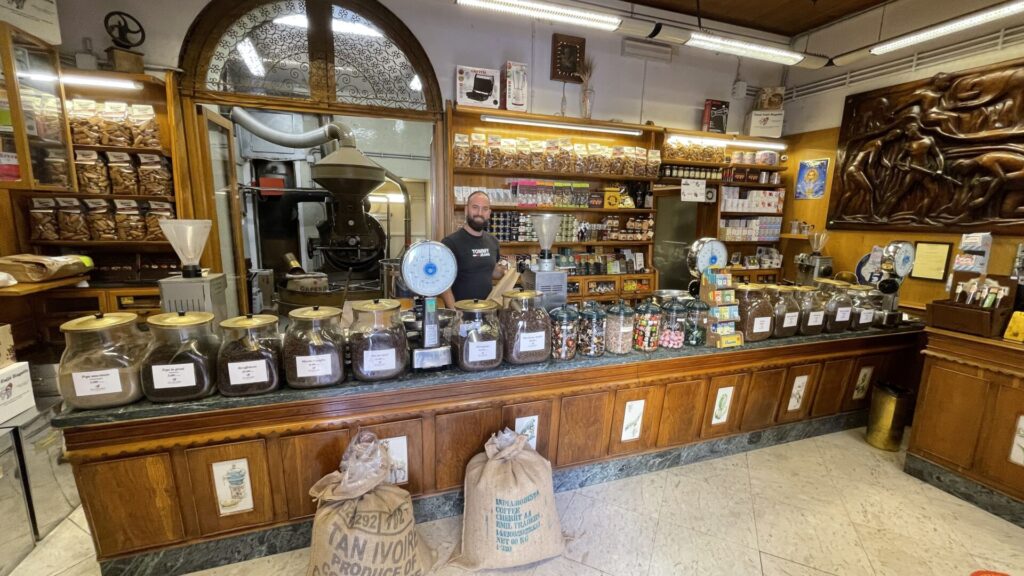
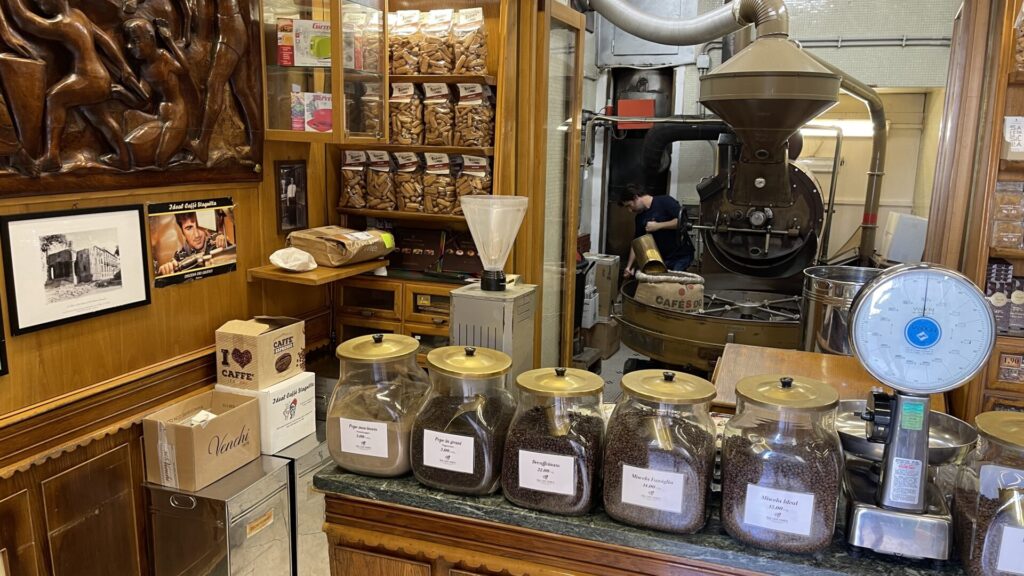
Torrefazione "Ideal" G. Stagnitta
For over a hundred years, everything has revolved around the aroma of brown gold in what is said to be Palermo's oldest coffee roastery. Even unusual varieties such as Kopi Luwak, Jamaica Blu Mountain or Nepal Mt. Everest Supreme can be found here. Our favorite, however, is the house blend Miscela Super Ideal.
Here you can not only buy coffee, but also enjoy it on the spot.
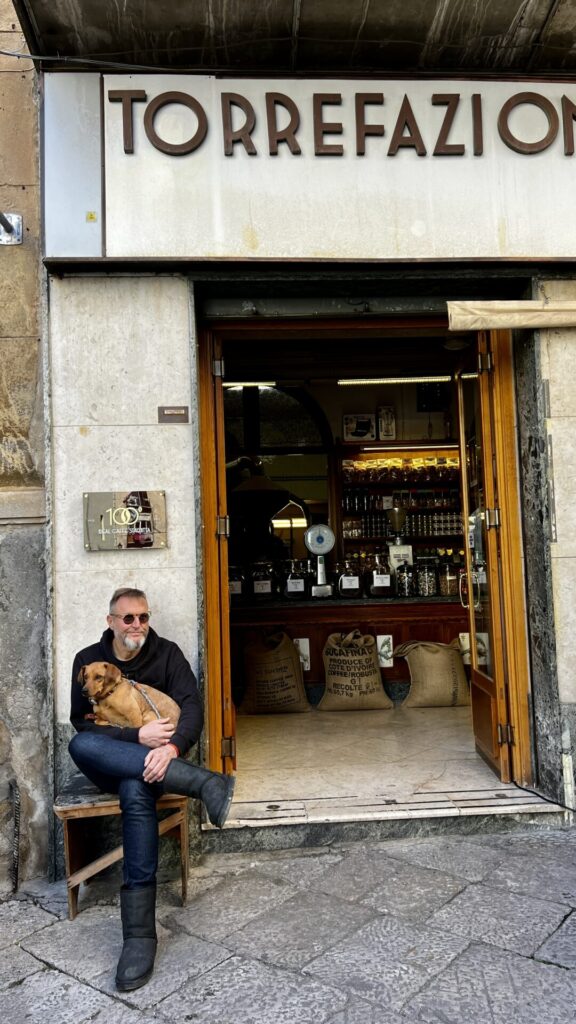
Here in the south of Italy, people especially love dark roasts. Preferably with a higher proportion of Robusta beans. This gives the coffee more bitterness, but less acidity and caffeine.
When Sicilians order their caffe, they naturally mean an espresso. Cappuccino, Latte Macchiato & Co, i.e. all coffee specialties with milk, are only drunk by Sicilians as breakfast, i.e. until lunch.


Piazza Pretoria
Right next to Piazza Bellini is Piazza Pretoria, with the Palazzo Pretorio of the same name. In this is the current city hall of the city.
Just in front of it is the Fontana Pretoria, colloquially called Fontana della Vergogna, Fountain of Shame. The fountain, with a circumference of 133 meters, a height of 12 meters and the sculpture of the Genius of Palermo at the top, was built in 1554. Today the fountain is one of the visitor magnets of the old town of Palermo. Around it stand and lie statues of river gods and nymphs. Their nudity was long rejected by the Catholic, prudish Palermitani.
The Kalsa was long considered the noble district of the Sicilian nobility, popularly known as the Leopards. With the nobility disappeared glamor and money. Thus, the old town quarter increasingly turned into the poorhouse of the city. In the meantime, everything has already been renovated in a bright and friendly manner. That is why today it is considered a popular destination for excursions. In the meantime, it seems almost forgotten that this old town quarter stood not only for the mafia, but also for anti-mafia hunters.
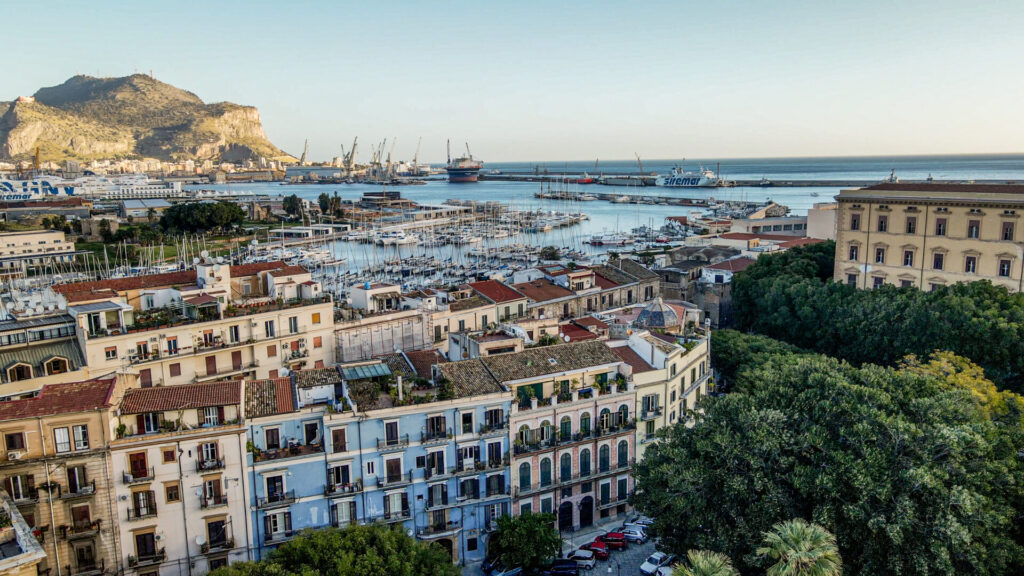
Piazza Marina | Park Giardino Garibaldi
La Kalsa comes from Arabic and means "the chosen one". But there is also the Italian name Tribunali. This comes from the Inquisition Court, which was located in Palazzo Chiaramonte-Steri. This is located directly on the Piazza Marina, as well as the park Giardino Garibaldi.
Here you can visit not only the palace. The park is also worth a detour. Here is a gigantic fig tree, as well as ornate fountains and busts. On Sundays, a flea market is held around the park. As always at flea markets, "the early bird catches the worm". As early as sunrise, you can watch the professionals haggle and learn. If you prefer a more relaxed atmosphere, you can sit down at Caffe Lucá.
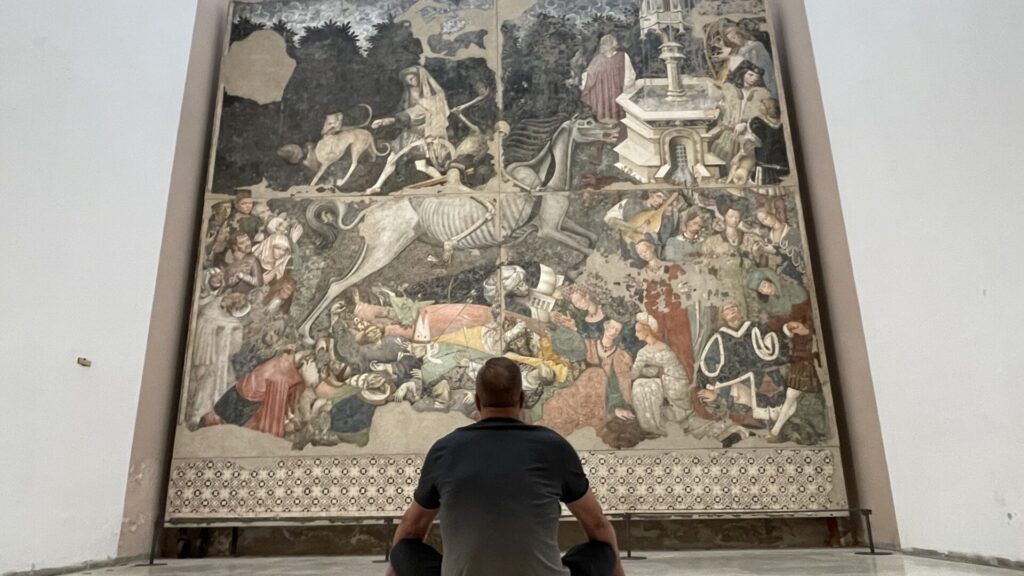
Palazzo Abatellis
This palace, also called Palazzo Patella, is just a few steps away in Via Alloro 4. It houses the Galleria Regionale della Sicilia. This is Sicily's largest art museum. Our highlight is the fresco "Il Trionfo della Morte", in German "The Triumph of Death".
In Wim Wenders' film "Palermo Shooting" it plays a leading role alongside Campino - we are not art experts. Better you make your own picture.
By the way, the film Palermo Shooting is worth watching not only because of Campino, but also regarding his shots of Palermo. The singer of the Toten Hosen is exciting, but some details are even more so. In 2008, the old town was not yet traffic-calmed. Where you stroll relaxed today, there is still traffic chaos in the film.
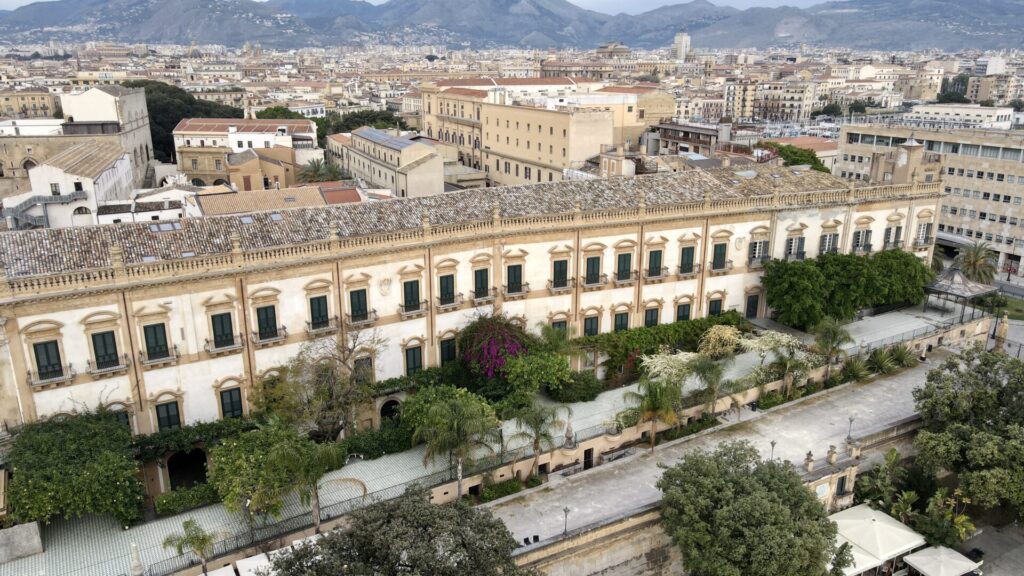
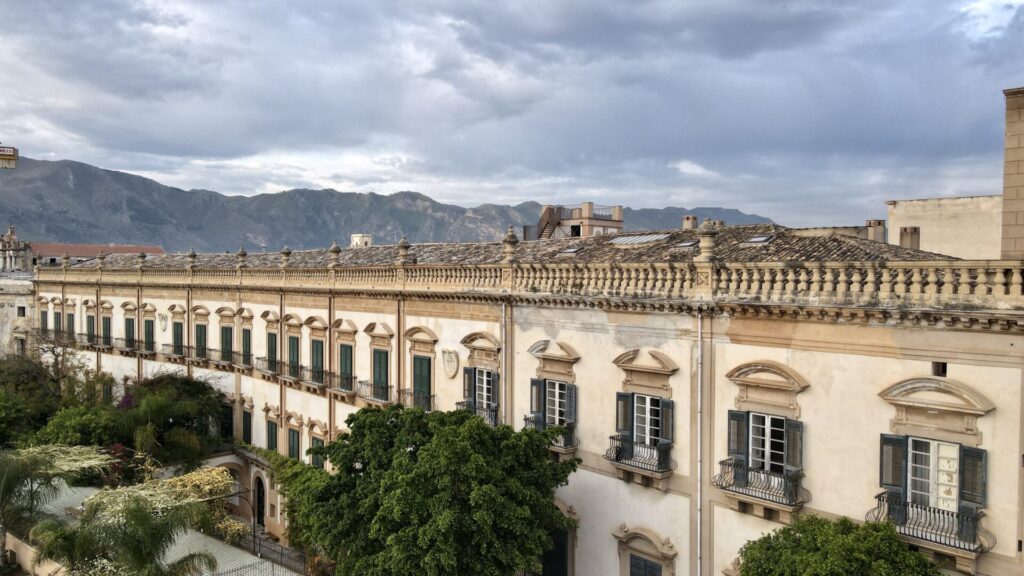
Palazzo Butera
This aristocratic palace in Baroque style, in the street of the same name, is even closer. It offers a fantastic view of Porta Felice and the adjacent marina. Here is the collection of Francesca and Massimo Valsecchi.
But there is more to discover. How about the Chiesa Santa Maria dello Spasimo, in Via dello Spasimo 15. This unfinished church from 1506 is perfect in its imperfection. For what is missing is only the roof. When is one so close to heaven?
Today, theater, music and cultural events are held here in the open air. At times it is closed. If this is the case, we recommend visiting the street art next door
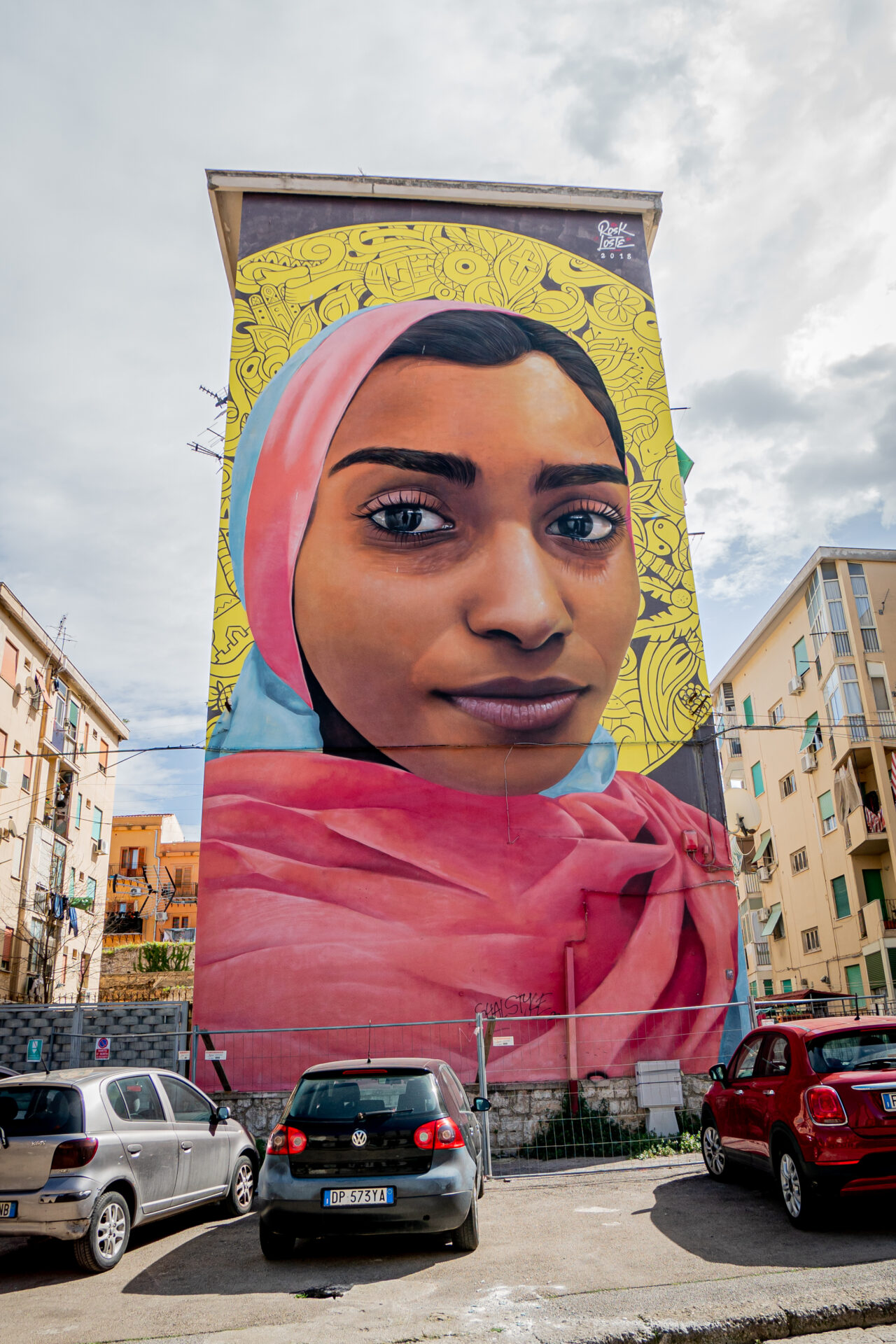
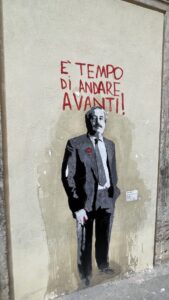
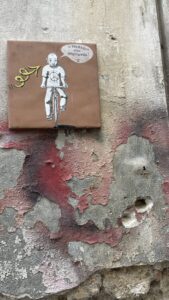
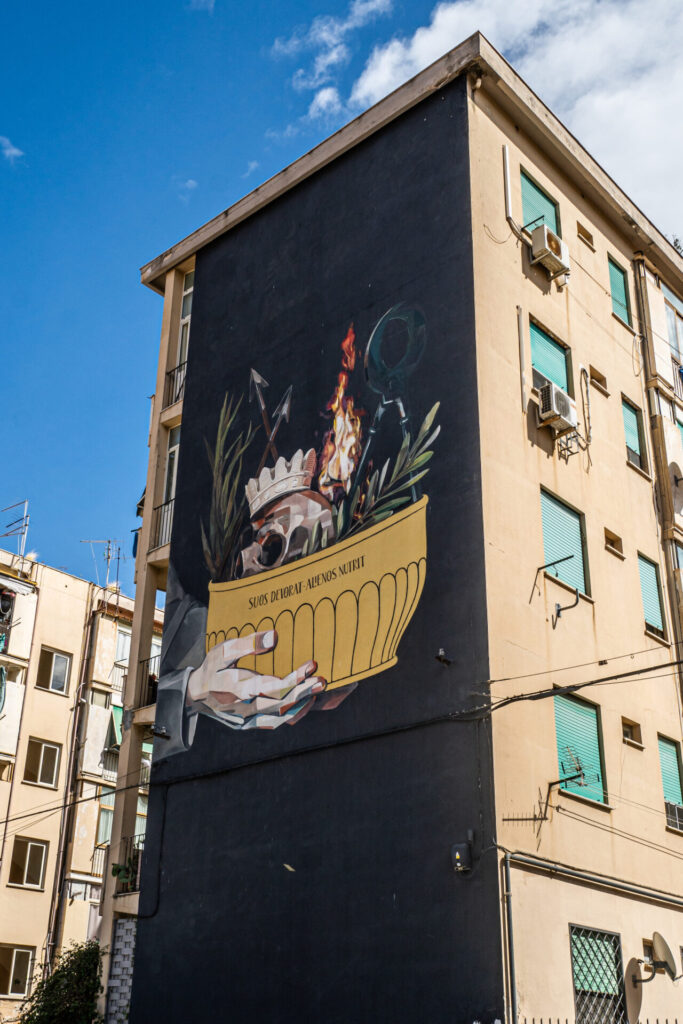
The mural was based on a photograph taken in Palermo on March 27, 1992 by Italian photographer Tony Gentile. Thus, only a few months before the bombing.
Palermo offers many such murals. The link to our article Palermo Street Art you will find soon alternatively here or at the end of this post.
The mural "Giovanni e Paolo" is located in Via Mura della Lupa 8 and thus at the historic port La Cala. However, this already belongs to the old town district Loggia. But it is not only the large motifs, but often also small ones that reflect the street art of Palermo. Here are a few words about these two well-known Mafi-hunters.
Giovanni Falcone and Paolo Borsellino
Both come from the Kalsa. The boy Giovanni from Via Castrofilippo 1 and Paolo from Via della Vetriera 57. There are not even 300 meters between the two houses. They not only knew each other since childhood. Like many other children, the later judges played together with their future defendants in the Oratory Square, the parish of San Francesco d'Assisi. The house where Giovanni Falcone was born no longer exists today. All that remains is a small commemorative plaque.
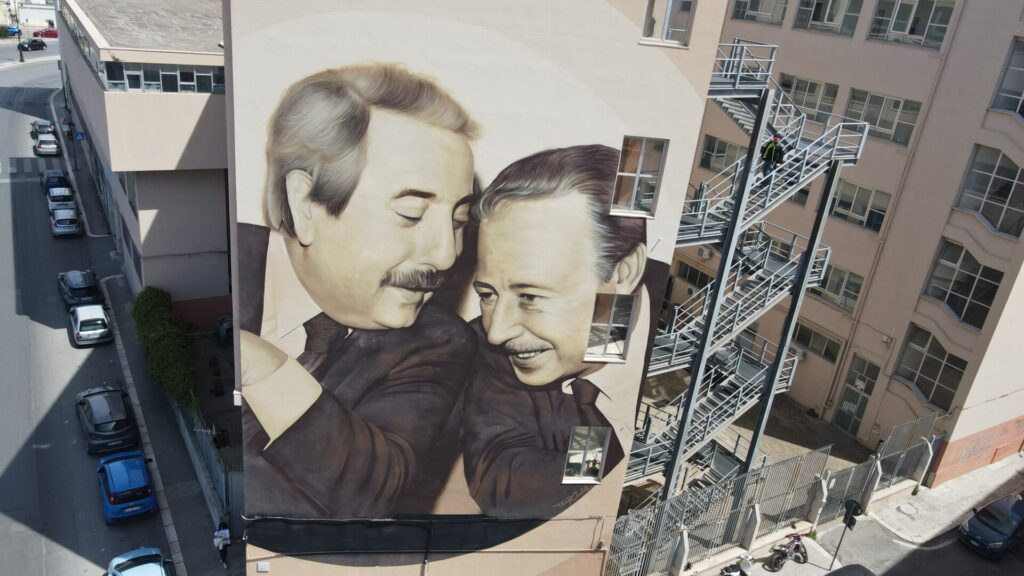
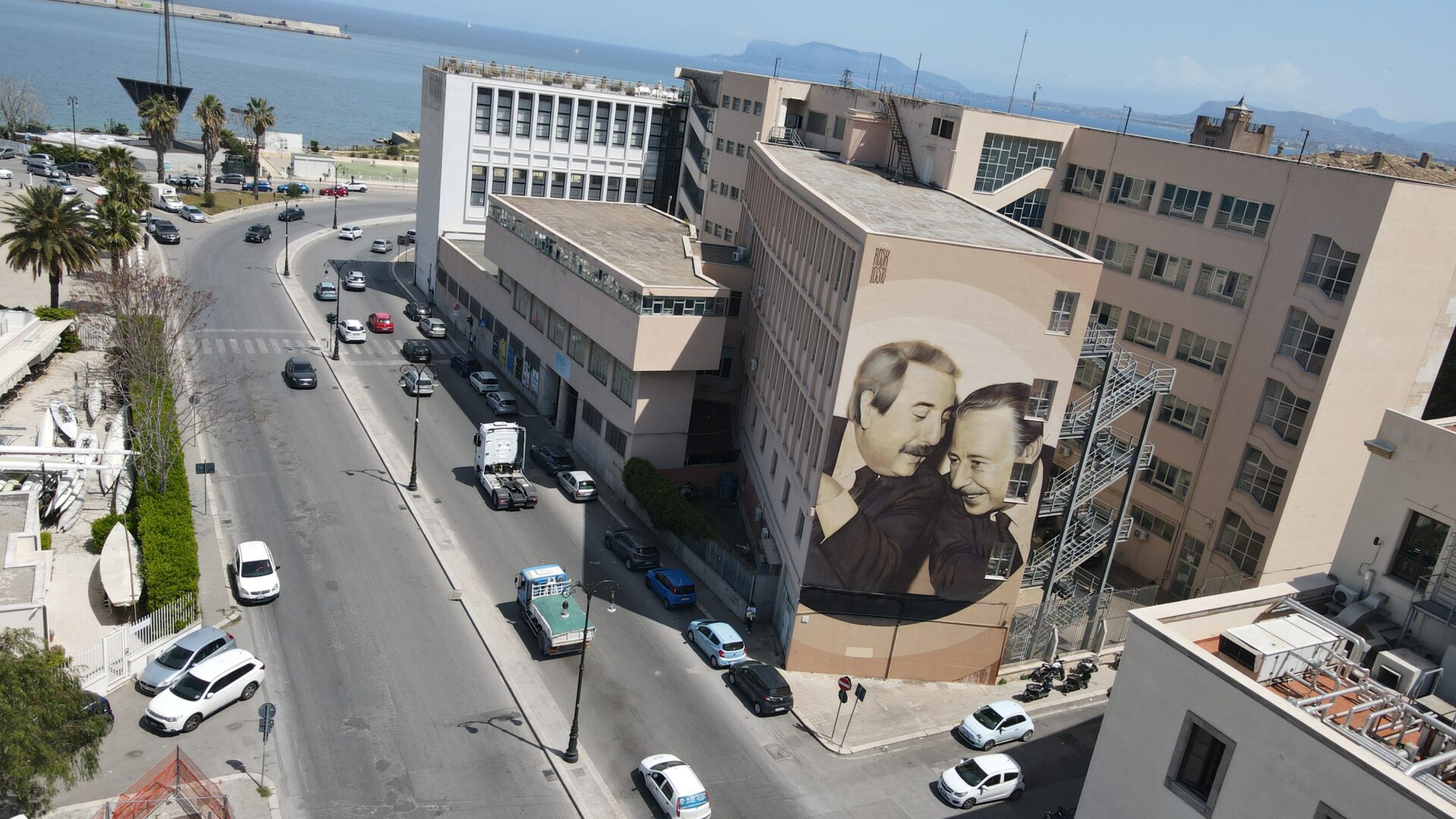
If you are drawn towards the sea, we recommend a walk along the waterfront. It is not yet one of the most beautiful promenades in the world. Therefore, a redesign is to take place in this regard in the next few years. Nevertheless, here, directly on the sea, you can enjoy the wind and the sun.
At the end of the promenade is Cala di Sant'Erasmo, a small harbor. And there you will find two nice restaurants overlooking the sea.
Fud Bocs
Here is the menu: https://www.fud.it/location/palermo/#menu-location
As we already describe below the sister restaurant in the old town district La Loggia, today we would alternatively recommend the following restaurant:
Molo Sant'Erasmo - Trattoria sul Mare
A distinctly modern seafood restaurant.
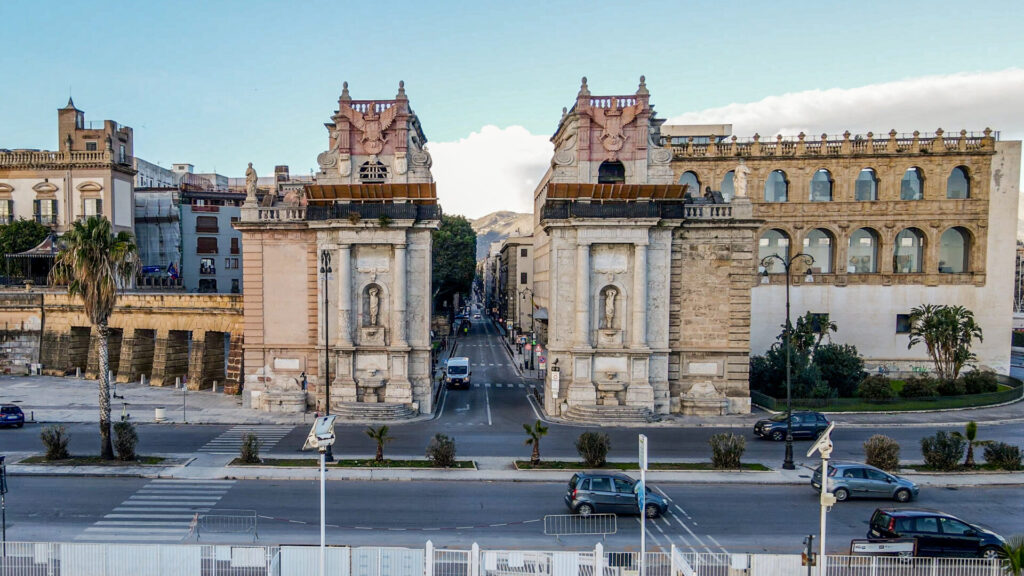
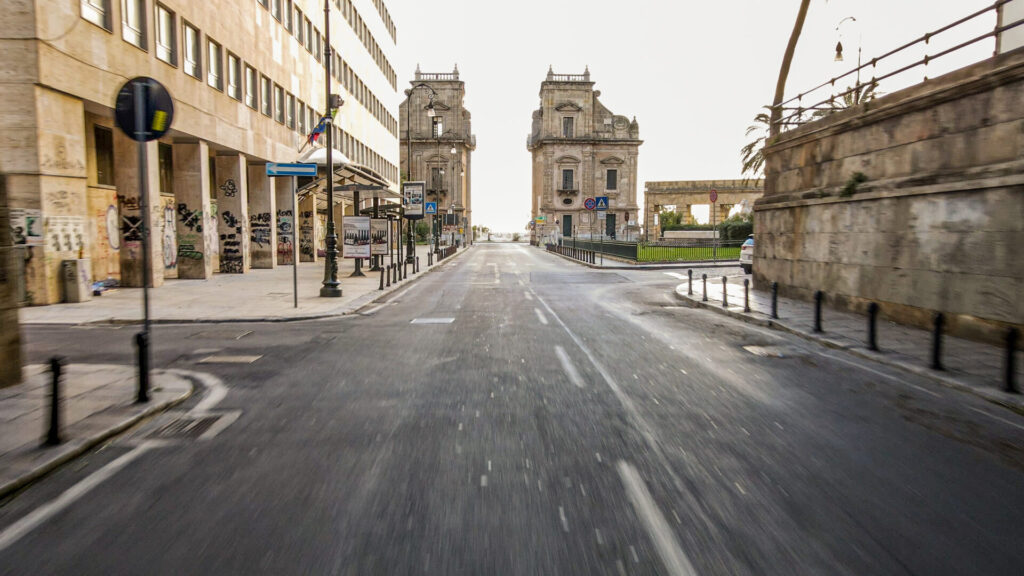
Old Town Quarter La Loggia - Castellammare
If you are looking for the above-mentioned mural "Giovanni e Paolo" at the port, a small detour via Corso Vittorio Emanuele is recommended. From here you can get to the promenade through Porta Felice. Now and then you can immortalize the sunrise directly between the city gate, as a photo.
But it is also necessary to look back. From the outside, at the very end of Corso Vittorio Emanuele, you can see Porta Nuova. The opposite city gate is almost 1.9 kilometers away. A great photo motif! Afterwards, you can combine the walk to the street art with a short stroll through the marina La Cala.
La Cala
The oldest part of the port of Palermo, is now mainly used as a marina. But also the customs administration and the harbor master still have their place here. It is not only connected to the newer part of the main port by two piers facing in opposite directions, but above all it is very well protected against swell.
This port is probably the cradle of Palermo. Because the port was built in a bay. Already since the 8th century BC, the use as a port by the Phoenicians is documented. Originally, this cut much deeper into the growing city. But this pushed back the port more and more over the years.
The fact that fish are now cavorting in the harbor basin is certainly a positive sign of urban development. For this was not always the case. In the past, the harbor was considered a cesspool. Until 2008, the sewage pipes of the old town ended here. In the meantime, the harbor was even considered a ship graveyard.
From here you not only have a beautiful view of the mural, but also of the old town quarter La Loggia, which rises slightly. Thus, the naming "The Lodge" is also understandable. Because the view, as if from a box, on the harbor and sunrise should have always had its charm. Especially in the knowledge that there, where today the marina La Cala is located, the Phoenicians landed more than 3,000 years ago.
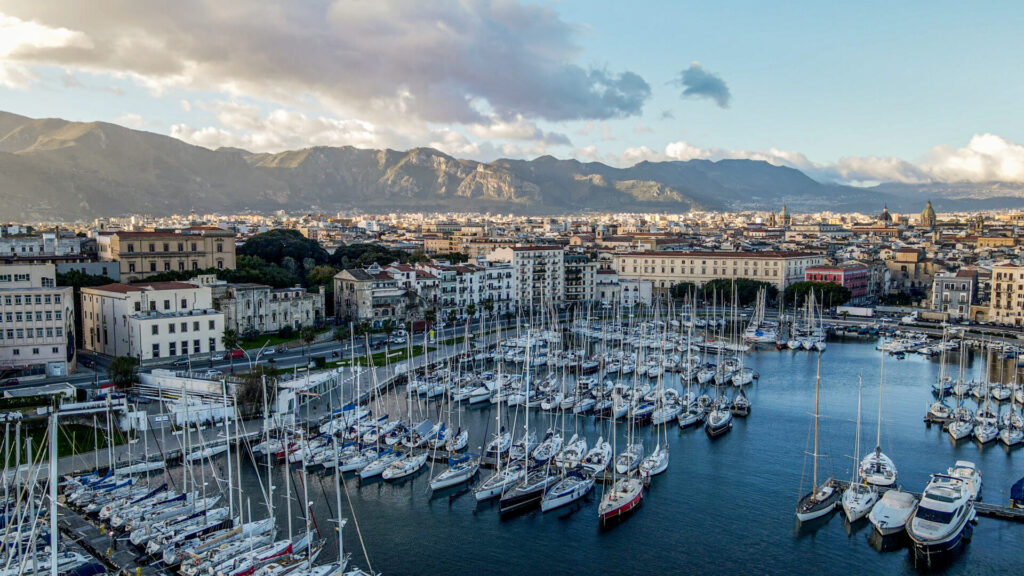
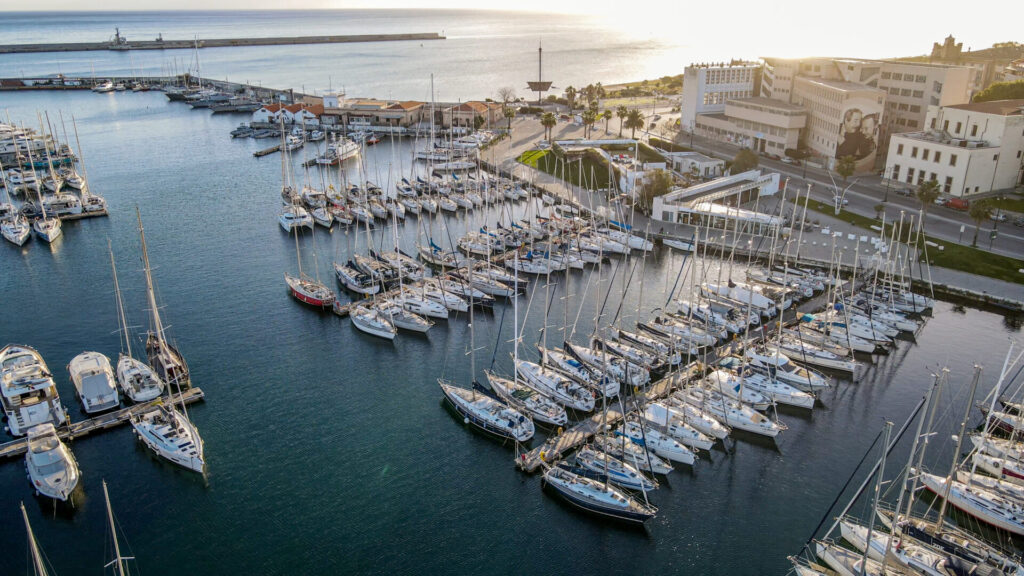
Rinascente
Of course, you can also store in the noble department store on Via Roma. Or you can enjoy a view of Palermo from the roof terrace, Piazza San Domenico with the Colonna dell'Immacolata, the column of the Immaculate Conception. But above all, here you have the best view of the Chiesa di San Domenico.
Chiesa di San Domenico
Built in the 13th century in the Gothic style as the first Dominican church, a Renaissance building followed in the 14th century. The two-towered Baroque facade is from the 17th century. Among several personalities buried in San Domenico is Giovanni Falcone.
To call Palermo's old town well laid out may be an exaggeration. But the distances are short. Thus, the famous judge found his final resting place just 950 meters from his birthplace, in Via Castrofilippo 1. The tombstone bears the inscription "Hero of the fight against the Mafia".
If the Rinacente's rooftop terrace is too sophisticated for you, but you're still thirsty for coffee, head next door to Radici's coffee bar.
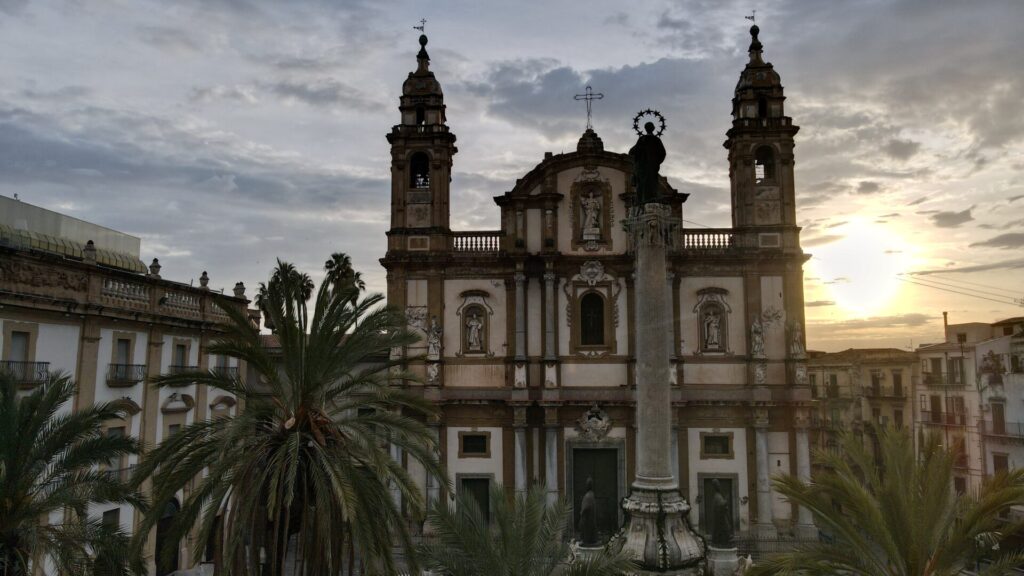
RADICI - Piccolo Museo della Natura
The small Museum of Nature is considered a cultural center for building, promoting and spreading a new ecological thought. Not just for ecos.
Alternatively, from Piazza San Domenico, you can dive into the alleys of Via Maccherronai. The narrow alley has a high density of restaurants and bars. Among them is the Taverna Azzura. Supposedly the oldest bar in Palermo. In any case, it is one of the most visited. In the evening, usually large crowds form in front of it in the alley.

Arrottino "knife sharpening" Cambria
Signore Cambria, one of the last arrotino, knife grinder in Palermo is also based here. Inside the Vucciria market, in 1927 Salvatore Cambria set up his workshop at number 30. He sharpened not only the knives of fishmongers and butchers, but also the knives for cutting leather and shoe soles and the scissors of seamstresses.
Gaetano, Salvatore's son, helped his father in the business from a young age and then took it over in the 1980s. Most of the customers are no longer there and their craft has also passed away. Nevertheless, the business is carried on by Gaetano's son, who, with his father by his side, preserves and continues what is probably the last and very rare craft of yesteryear.
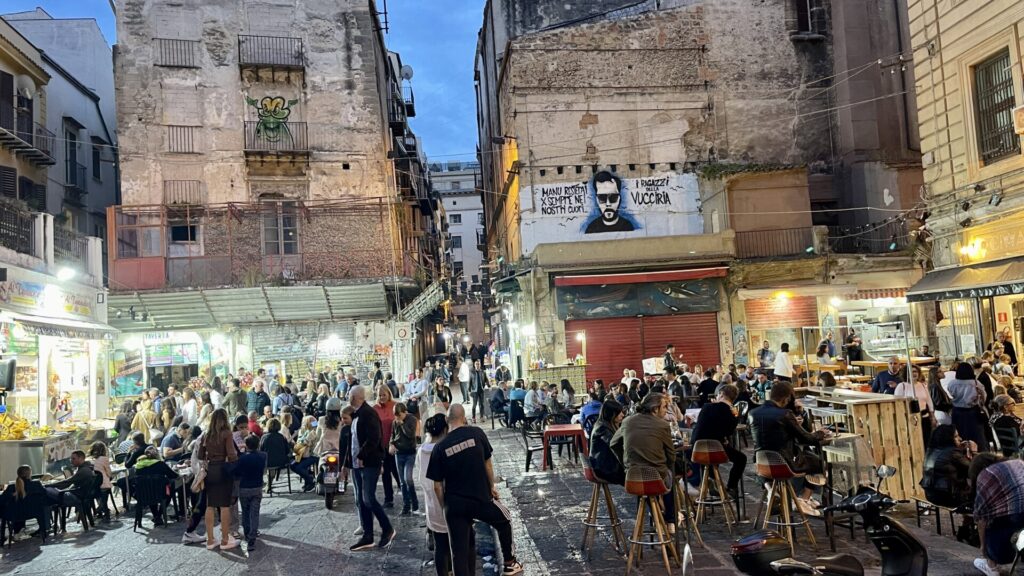
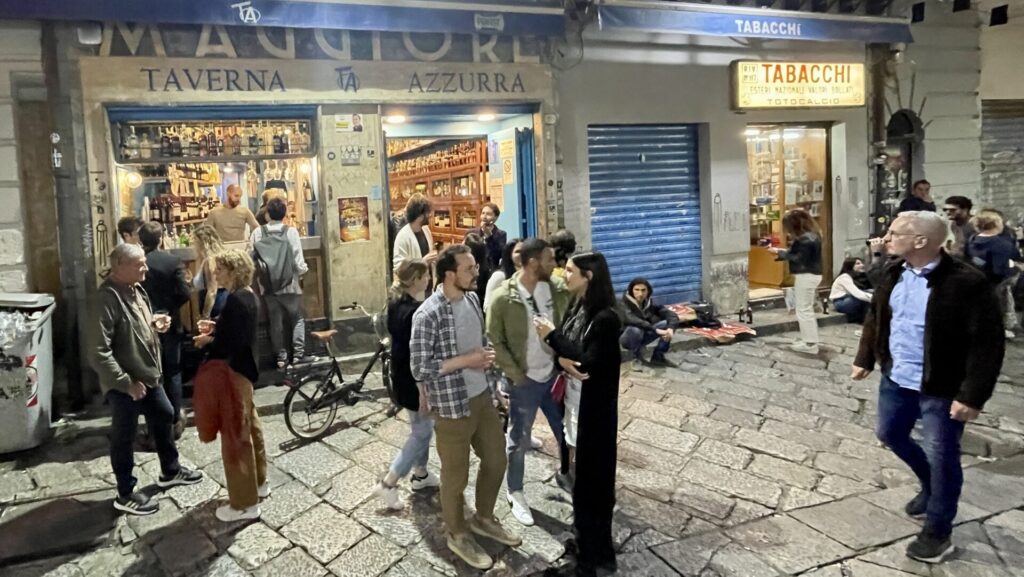
Mercato di Vucciria
At the end of the alley is Piazza Caracciolo. Here is the heart of another historic market of Palermo, Vucciria. It is also the oldest market in the Castellammare district.
Il Genio del Garraffo
Sicily and especially Palermo has attracted not only conquerors but also merchants.
So it happened that descendants of the merchants who came in the 12th and 13th centuries from northern Italy, today's France and Spain, had their loggias in the Vucciria market. To thank the city for welcoming them, in the 15th century they erected a sculpture in Carrara marble in the middle of Via Argenteria. It represents the Genius of Palermo, a patron god.
Museo Archeologico Regionale Antonino Salinas
For those who want to delve further into the history of Palermo and Sicily, we recommend the Archaeological Museum in Piazza Olivella, next to the Chiesa di Sant'Ignazio all'Olivella. The visitor can expect archaeological finds from the prehistory of the island to the late Roman period. But the museum building alone, which is located in an old monastery complex, is worth a visit.
Chiesa di Sant'Ignazio all'Olivella
The facade was built in the Baroque - Roman style in the 16th century. Most of the church complex belongs to the adjacent museum. But the oratory of San Filippo Neri is certainly a beautiful photo motif.
Enough culture, the stomach growls? Then just turn around.
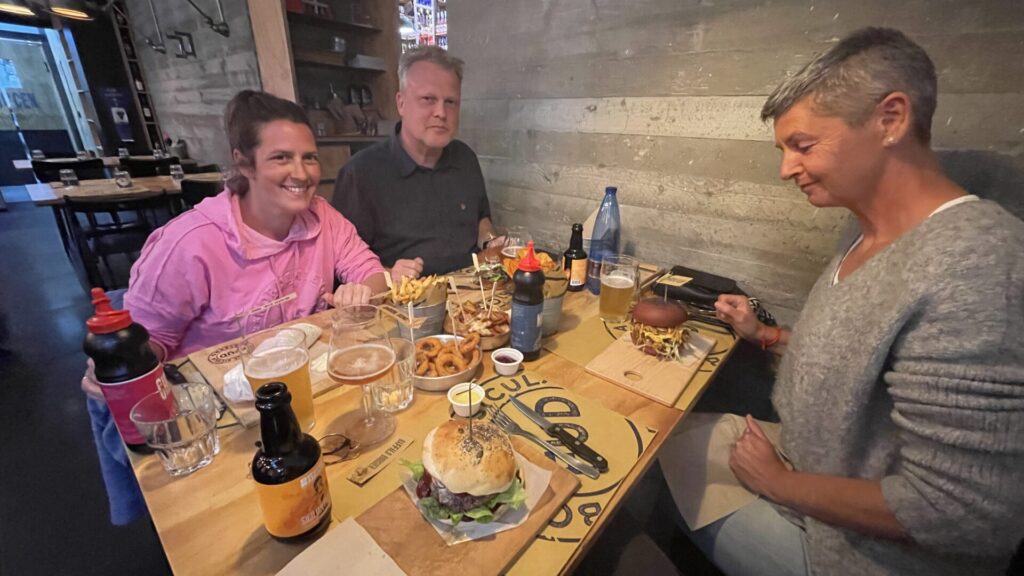
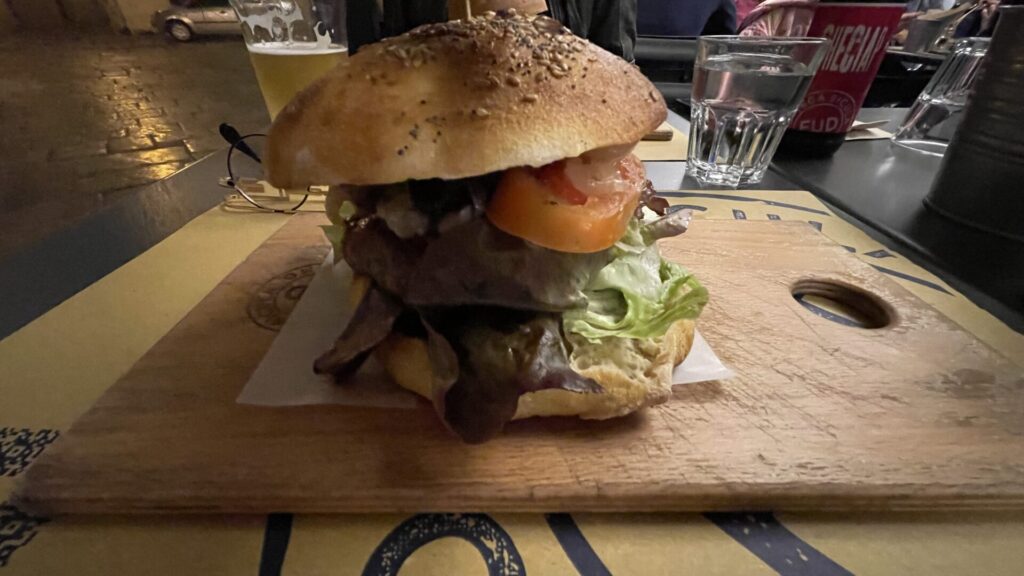
FUD
Just across the street at Piazza Olivella 4 is FUD, a BURGER restaurant both outstanding and stylish. My recommendation of SHEK BURGER, donkey meat, tomato, mixed salad, buffalo mozzarella, mushrooms, giarratana onion, on homemade bread and... Accompanied by a few homemade potato chips....
It's still too early for burgers? You prefer pasta?
Antica Focacceria del Massimo
Between Piazza Olivella and the nearby Teatro Massimo is Via Bara All'Olivella. Here, just before Via Maqueda, you will find the Antica Focacceria del Massimo.
Between 12:00 and 16:00 you can eat here cheap, good and typical Sicilian. The selection is usually limited to three main courses, plus a few small dishes. Simply delicious. We love this restaurant.
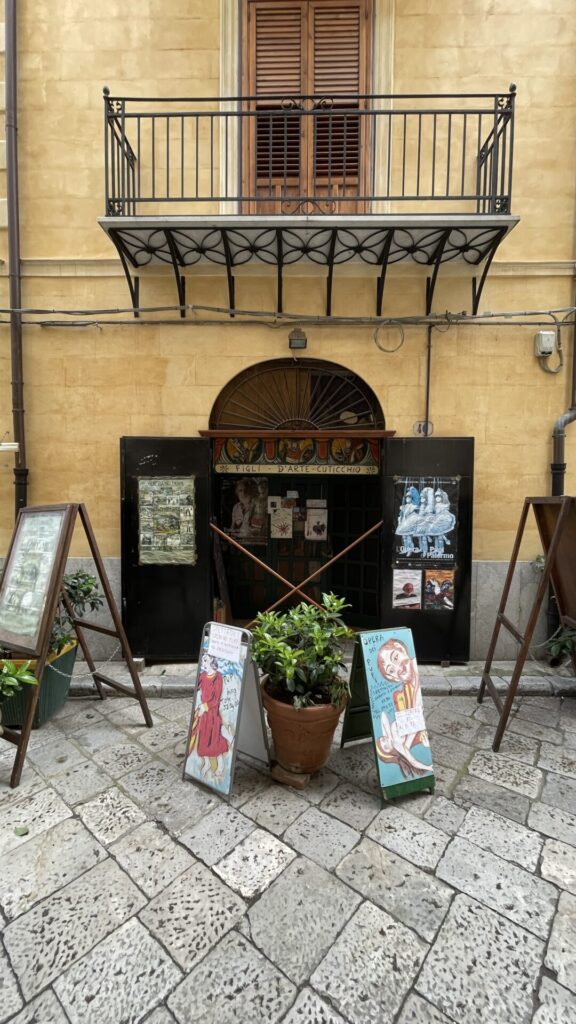
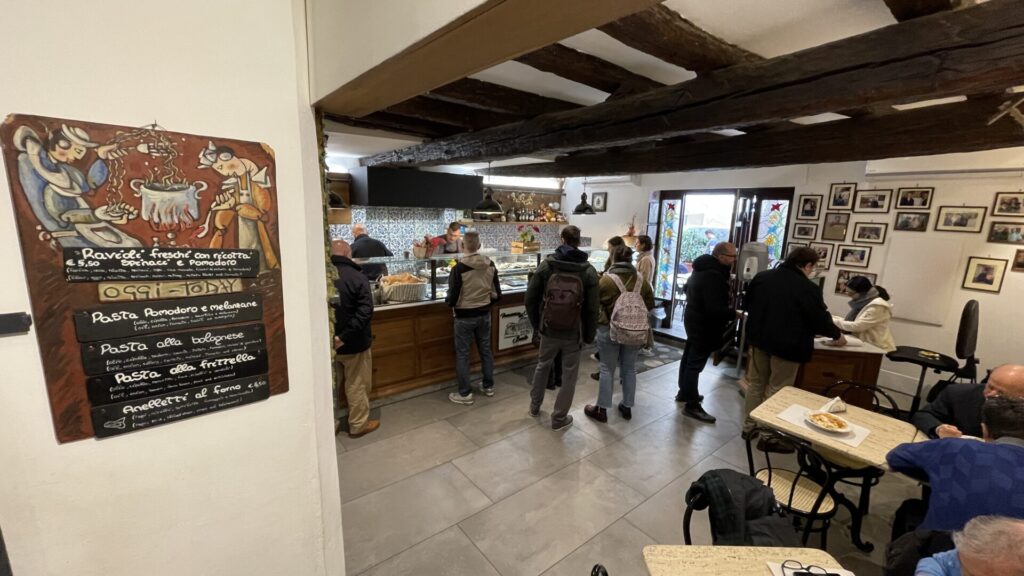
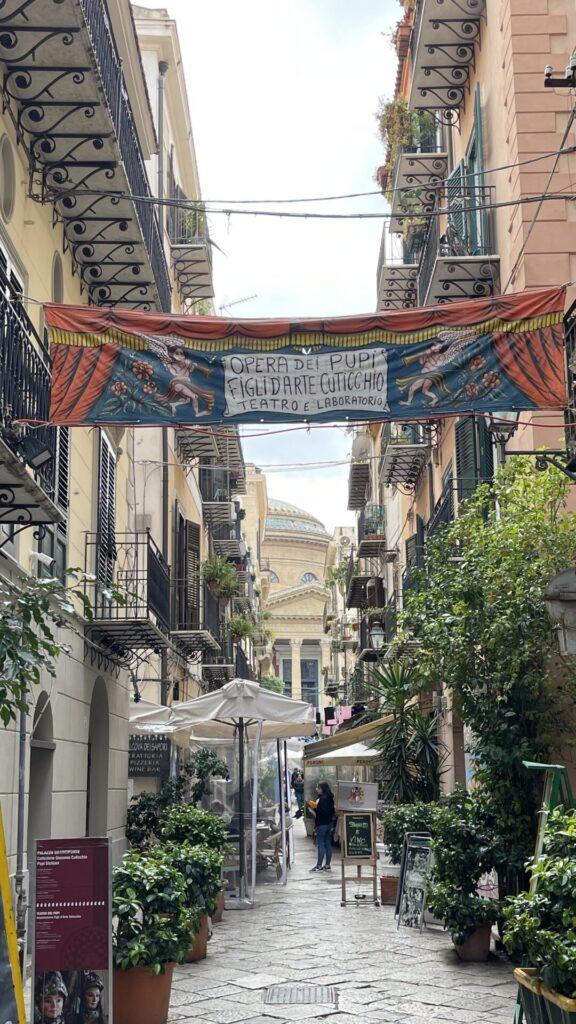
Teatro dei Pupi di Mimmo Cuticchio
Almost next door, in Via Bara All'Olivella 95, for 85 years there has been the city-famous puppet theater of Mimmo Cuticchio.
They say that when Mimmo Cuticchio is not making the knight puppets dance in his theater, he is carving more puppets next door in his workshop as souvenirs. In Palermo, many things are different. For example, the puppets are not classic marionettes. The heavy, Sicilian puppets are not moved on strings, but on metal rods. Today there are only very few of the formerly numerous puppet theaters.
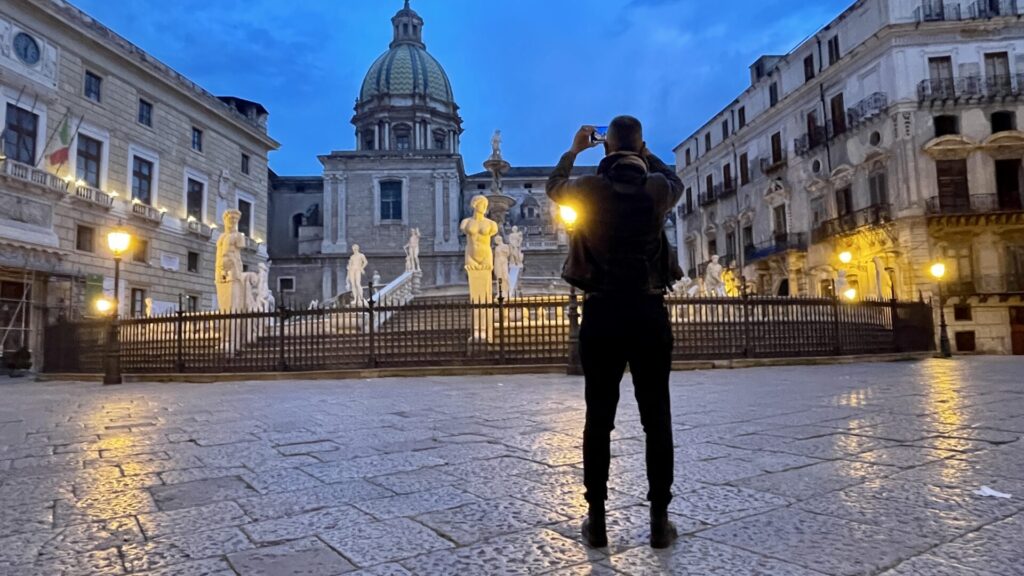
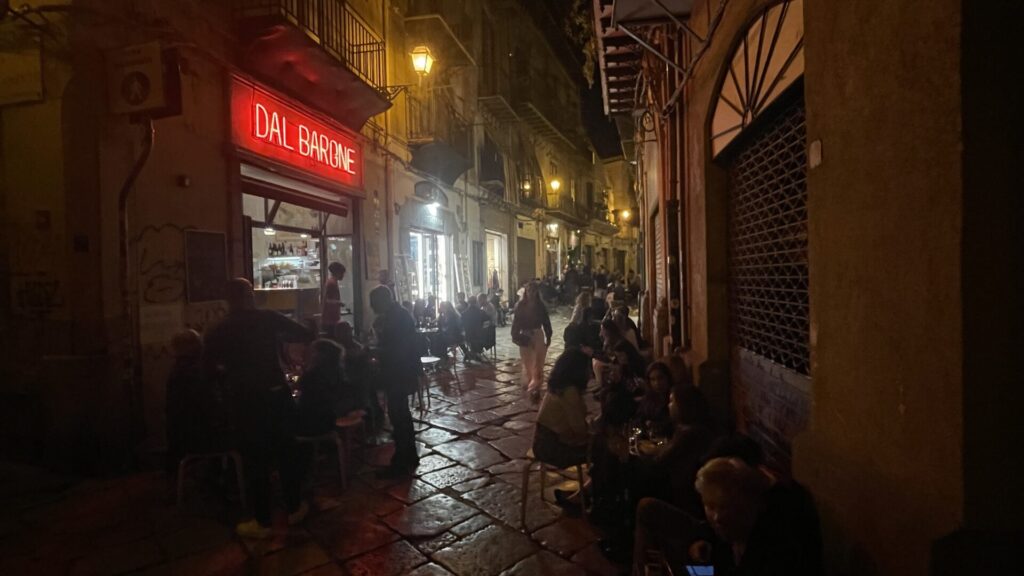
Palermo day and night
Palermo transforms during the day and shows very different facets. Early in the morning, right at sunrise, you experience Palermo fully relaxed.
The streets are still quiet and empty. The pavement is shiny. The merchants are still drinking a coffee and smoking a cigarette. The street sweepers are still sweeping away the garbage of the night.
During the day, the city is lively. Only during the siesta it gets a little quieter.

With the evening, the night owls come out. Later in the night it becomes quiet. Only at the Mercato di Vucciria is still celebrated. - Everyone finds his place in this city, tranquillo.
Added value - Links
Ciao, travelers and connoisseurs! If you are looking for the perfect home away from home in Palermo, we have just the thing for you: Palazzo Vetrano, an exceptional apartment in the heart of the old town. Here you can expect historical charm, modern comfort and an unbeatable location in the Centro Storico.
And that's just the beginning! Dive deeper into the vibrant world of Palermo and discover that the Centro Storico is more than just an ordinary old town. Follow us on to Mercato di Ballaro, where you can not only find street food, but also taste a piece of Palermo's soul. But beware: Palermo street food can be addictive!
When you've had enough of feasting, let yourself be enchanted by Palermo's street art. Here, walls become canvases and graffiti becomes works of art. And if you want to feel the adrenaline in your veins, experience the Targa Florio - a street race that makes Sicily shake! Prefer to discover a small fishing town? - How about Cefalù - So, discover the diversity of Palermo and Sicily. Start here:
- Palazzo Vetrano - The somewhat different vacation apartment
- Palermo Centro Storico: [More than just an old town?]
- Mercato di Ballaro: [Palermo's oldest market offers more than street food
- Palermo Street Food:
- Street Art Palermo:
- Targa Florio Part I and Part II
- Cefalù - More than a fishing village
And if you want to retire after an exciting day, Palazzo Vetrano, the perfect apartment in Ballaro, Palermo Old Town awaits you. Here you can relax and plan new adventures. Book today and make your dream vacation come true!

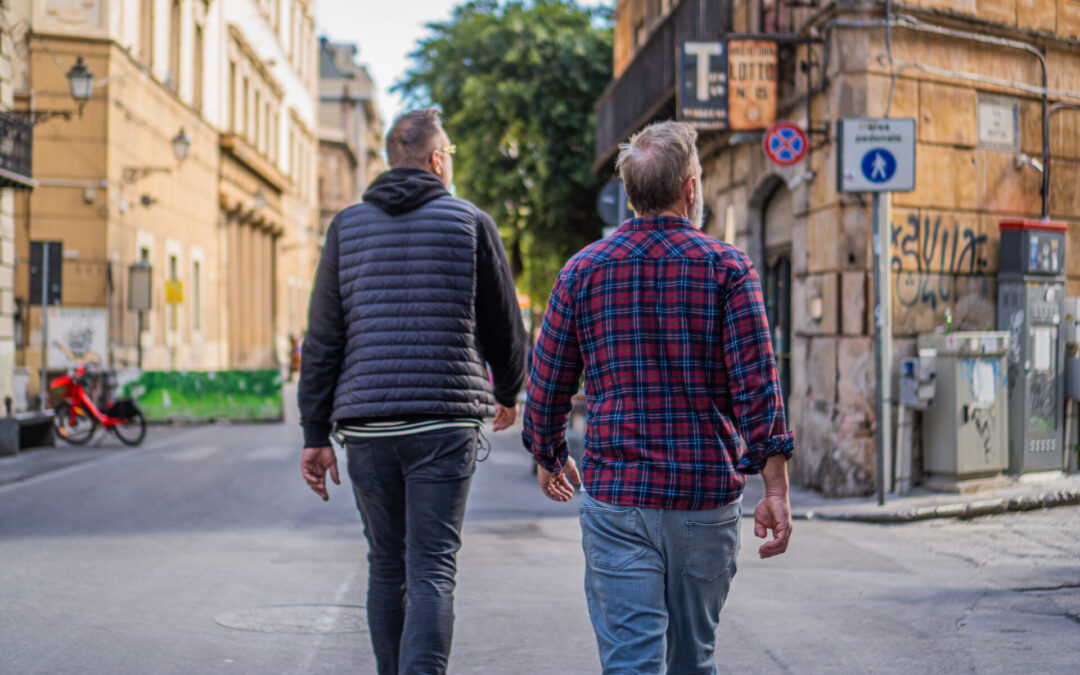
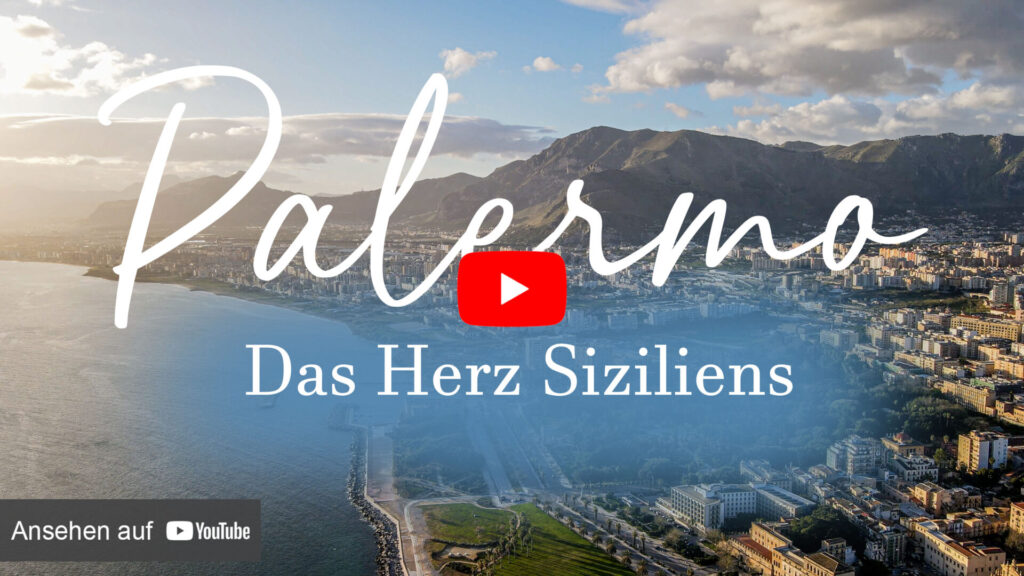

Very cool. A great document and a great film!!!
We were also extremely impressed by the morbid charm a few years ago - good memories!
Hello Carsten,
absolutely. Certainly, this is not a city for everyone. But who wants to be everyone?
Hello dear Torgit, dear Marc,
do you speak Italian or how do you communicate? (Everyday life is something different than vacation ...).
Best regards from Bernhard
Hello Bernhard,
we are learning Italian. But we have to realize that it's not quite so easy to learn a new language. 🧐
It's not safe anywhere in the world. We were also out and about late at night in Palermo. I never felt unsafe, even though I had to walk longer and through lonely alleyways to get to my car. I feel safer in Sicily than at home in Germany
Ciao Heike,
"I feel safer on Sicily than at home in Germany" - Exactly my words!!! - That's why we moved our home to the island.
See you soon again in Sicily
Servus Ihr Zwei !
Zuerst einmal ziehe ich den Hut vor euch, denn ihr habt das gewagt, wovon viele träumen und ebenso meine Frau & ich . Wir sind oft in Italien haben es aber noch nicht auf Sizilien geschafft. Eure Bilder und Berichte über die Insel haben uns mal wieder dazu gebracht, doch wieder ein wenig mehr über das Auswandern auf diese Insel nachzudenken.
Lebt Ihr nur von Ersparnissen oder habt Ihr Einkünfte auf der Insel ( außer der Ferienwohnung in Palermo ) ?
Viele Grüße aus dem Süden von Deutschland
Ciao Jan, herzlichen Dank für das nette Feedback. Zurzeit haben ich keine weiteren Einkünfte. Unser Fokus ist darauf ausgerichtet anzukommen, Land, Leute, Sprache und Kultur kennen zu lernen. Später möchte ich hier noch etwas arbeiten.
Servus Marc, wir planen für Mitte bis Ende September auf Sizilien zu fahren und würden uns eventuell ein paar Tage in eure Ferienwohnung einmieten wollen. Gibt es eine Möglichkeit in der Nähe für unseren T4 zu parken ? Herzliche Grüße aus Kiefersfelden Jan
Ciaoi Jan,
T4 hört sich spannend an. Wie sieht er aus?
Schön, dass wir Euch für Palermo begeistern können. Es gibt mehrere Möglichkeiten: Du kannst den Bus in der Nähe der Wohnung auf einem bewachten Parkplatz abstellen.
In der Stadt brauchst Du praktisch kein Auto. Für weitere Details können wir auch gerne mal über WhatsApp schreiben oder telefonieren.
Dies läuft über meine deutsche Nummer: +49 173 2020810